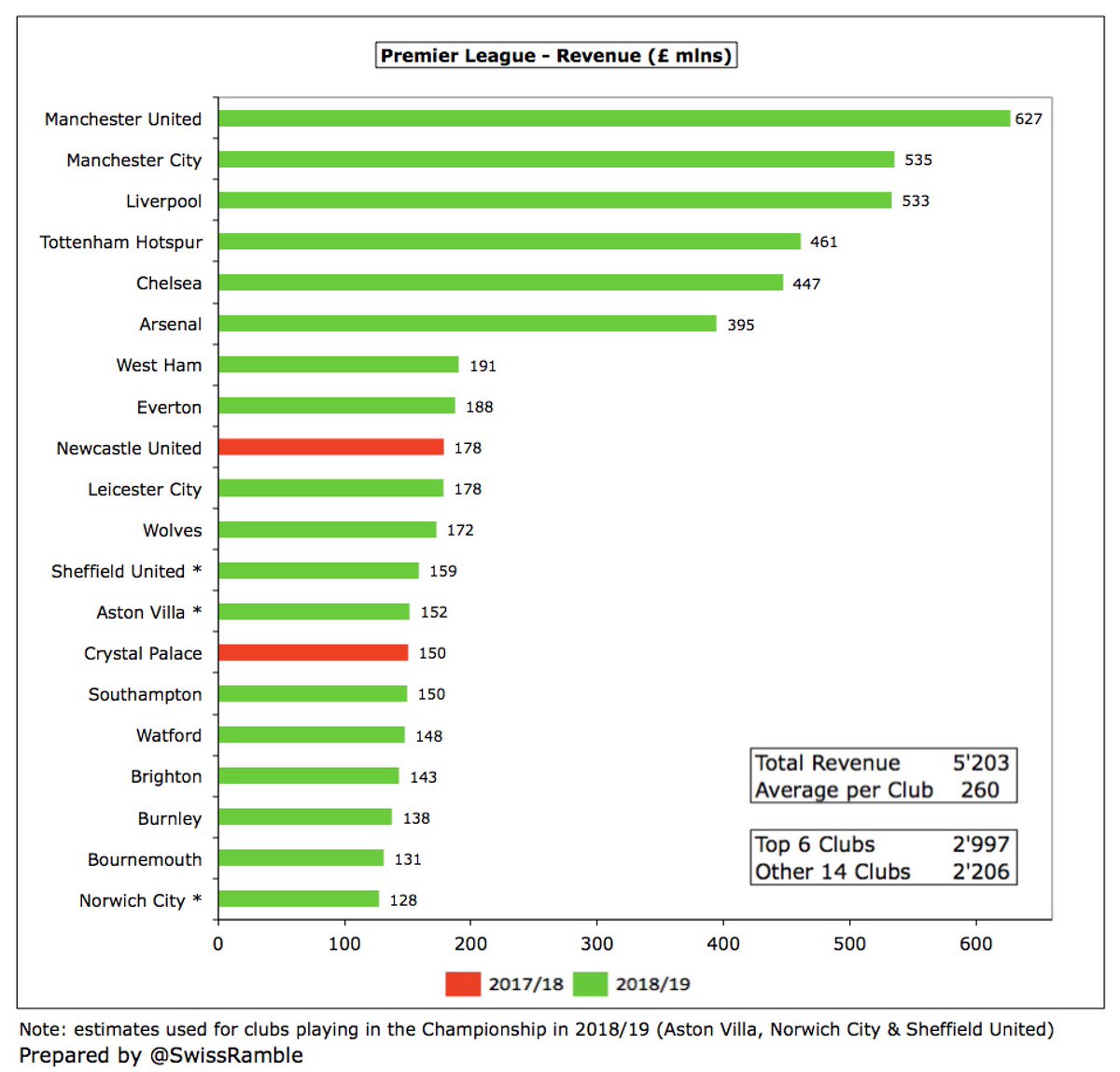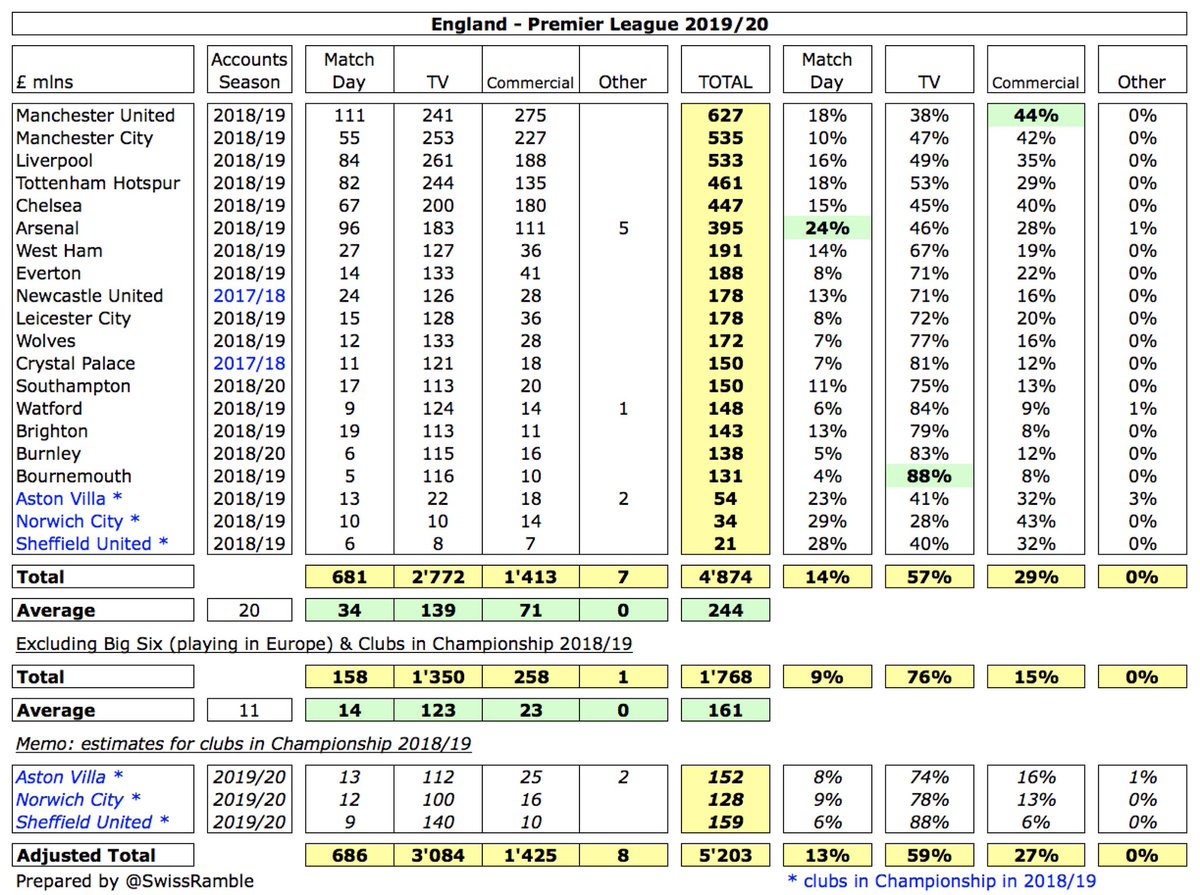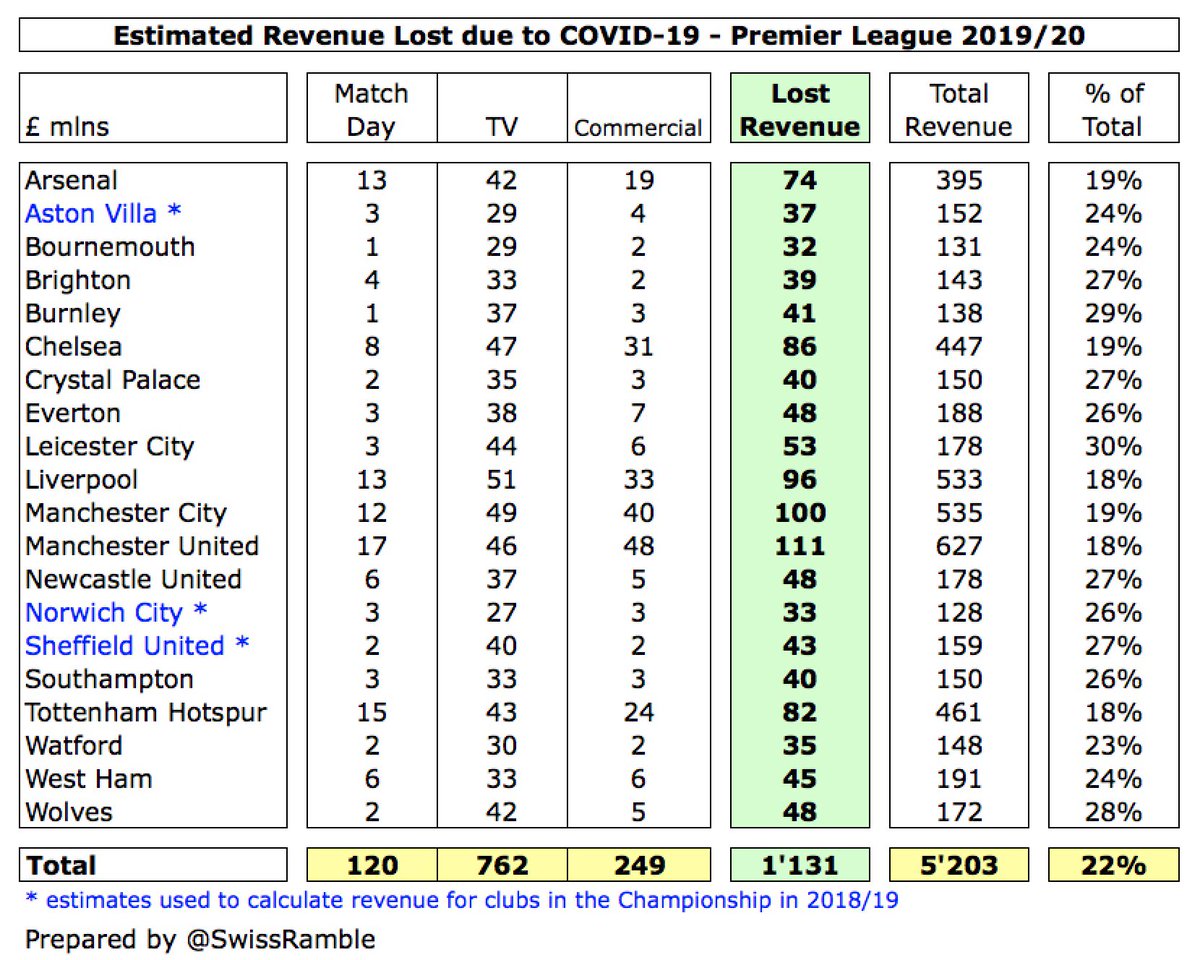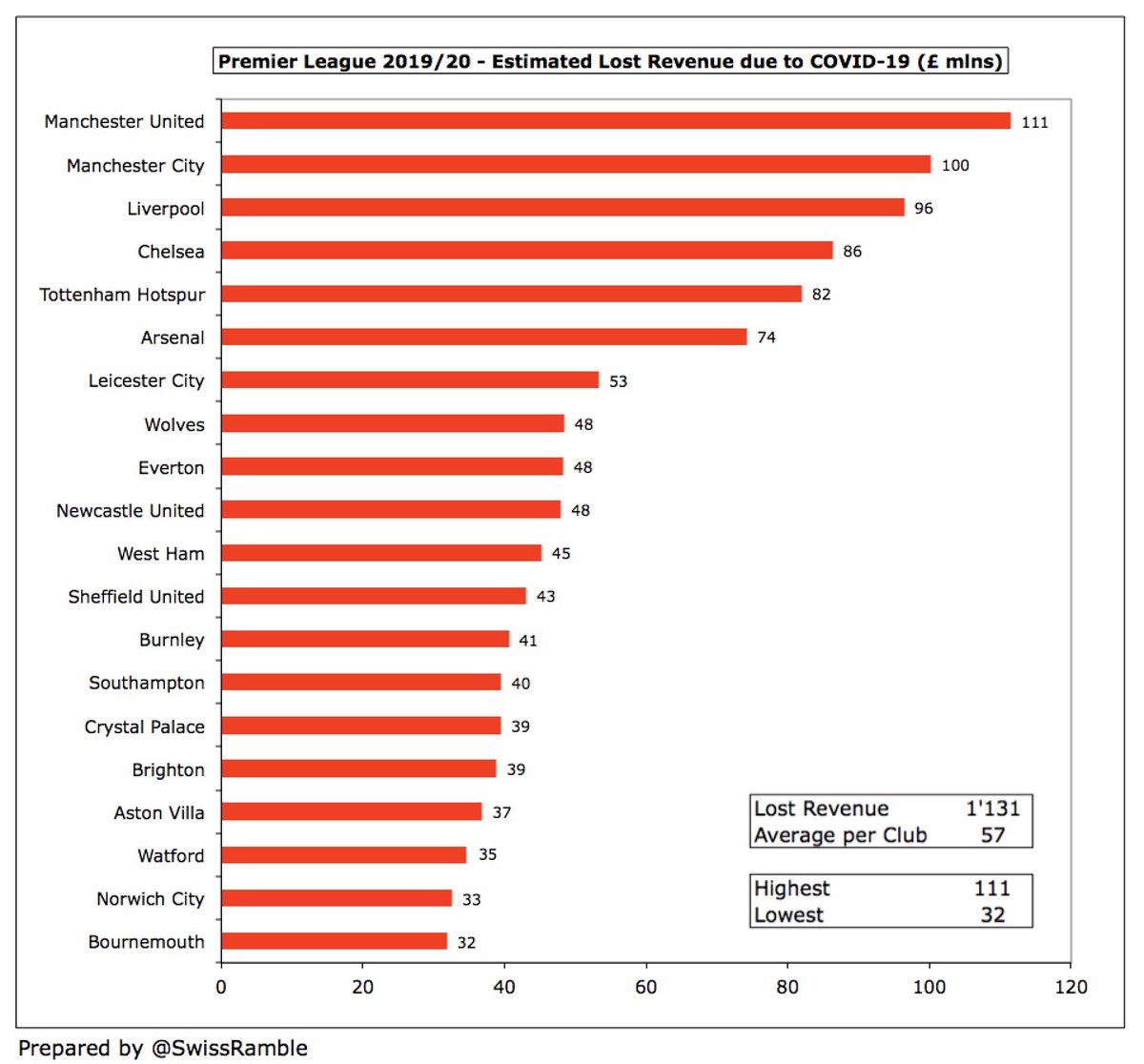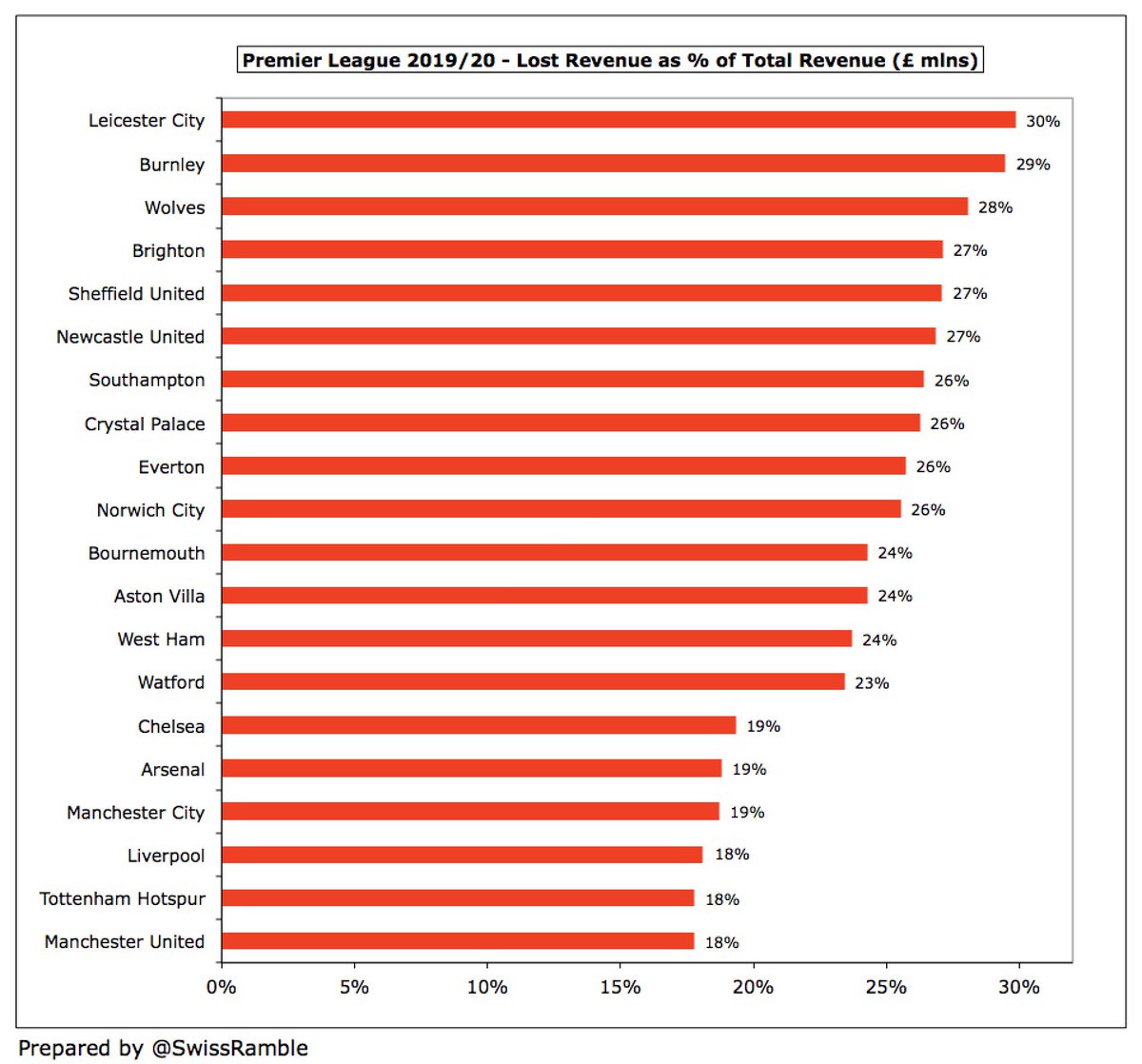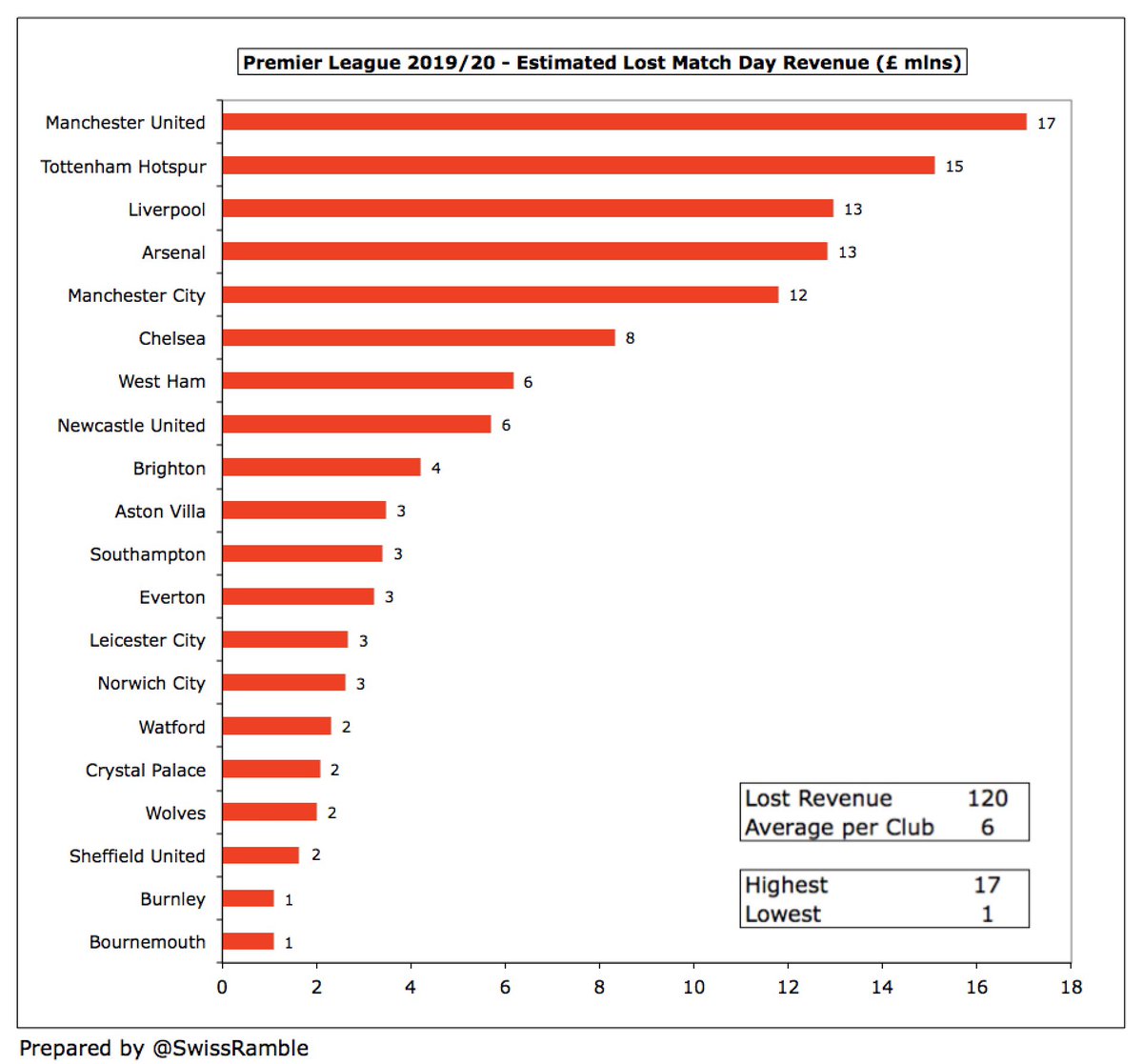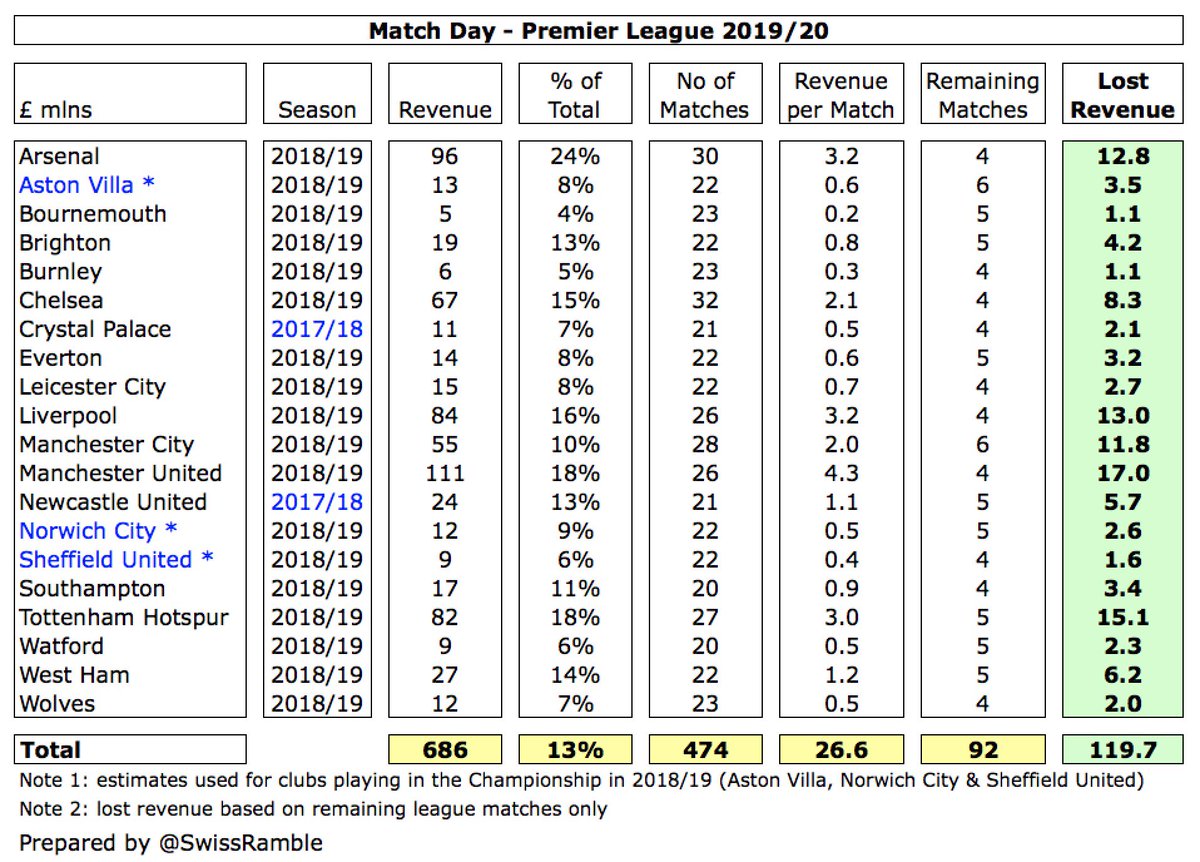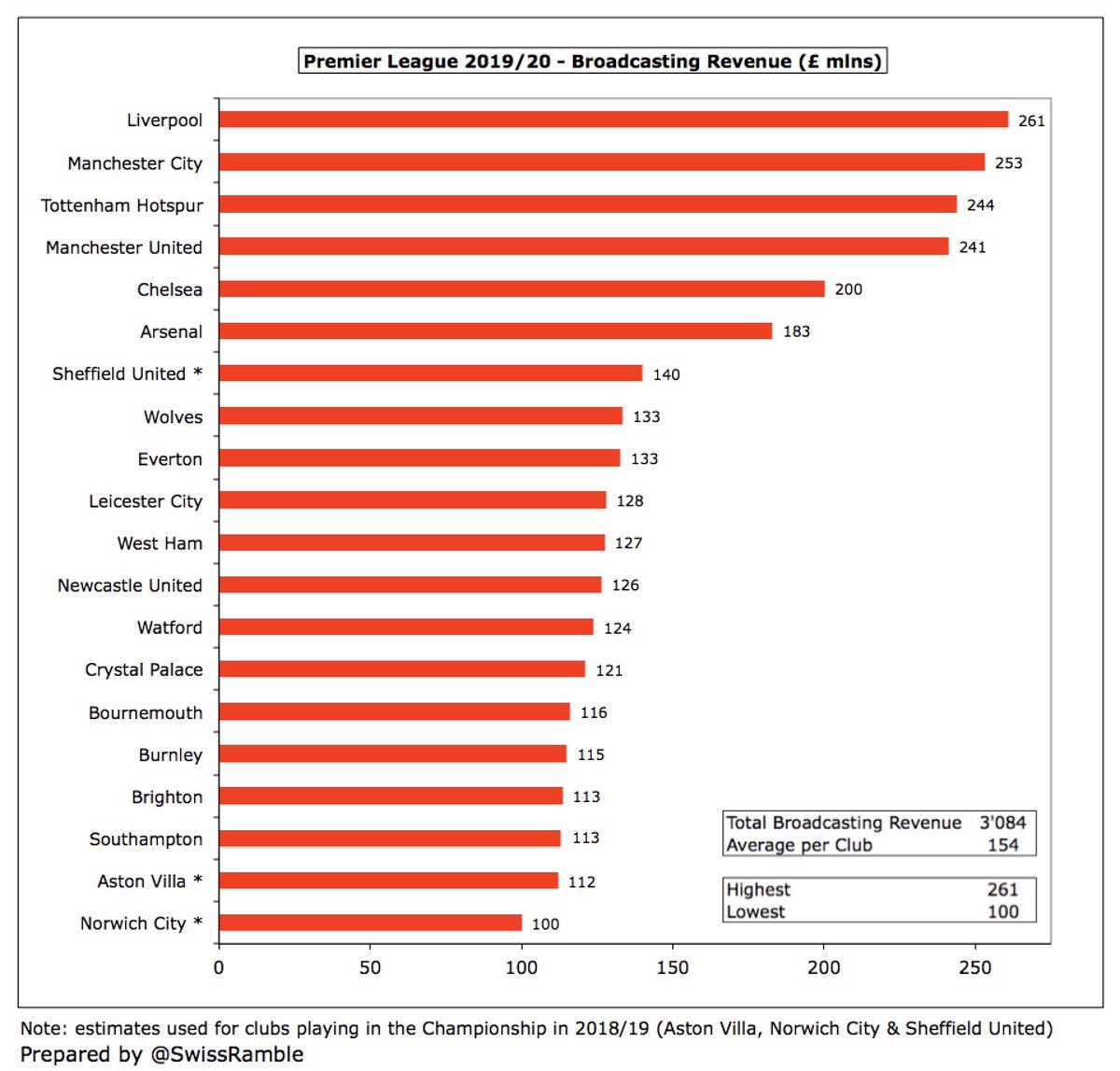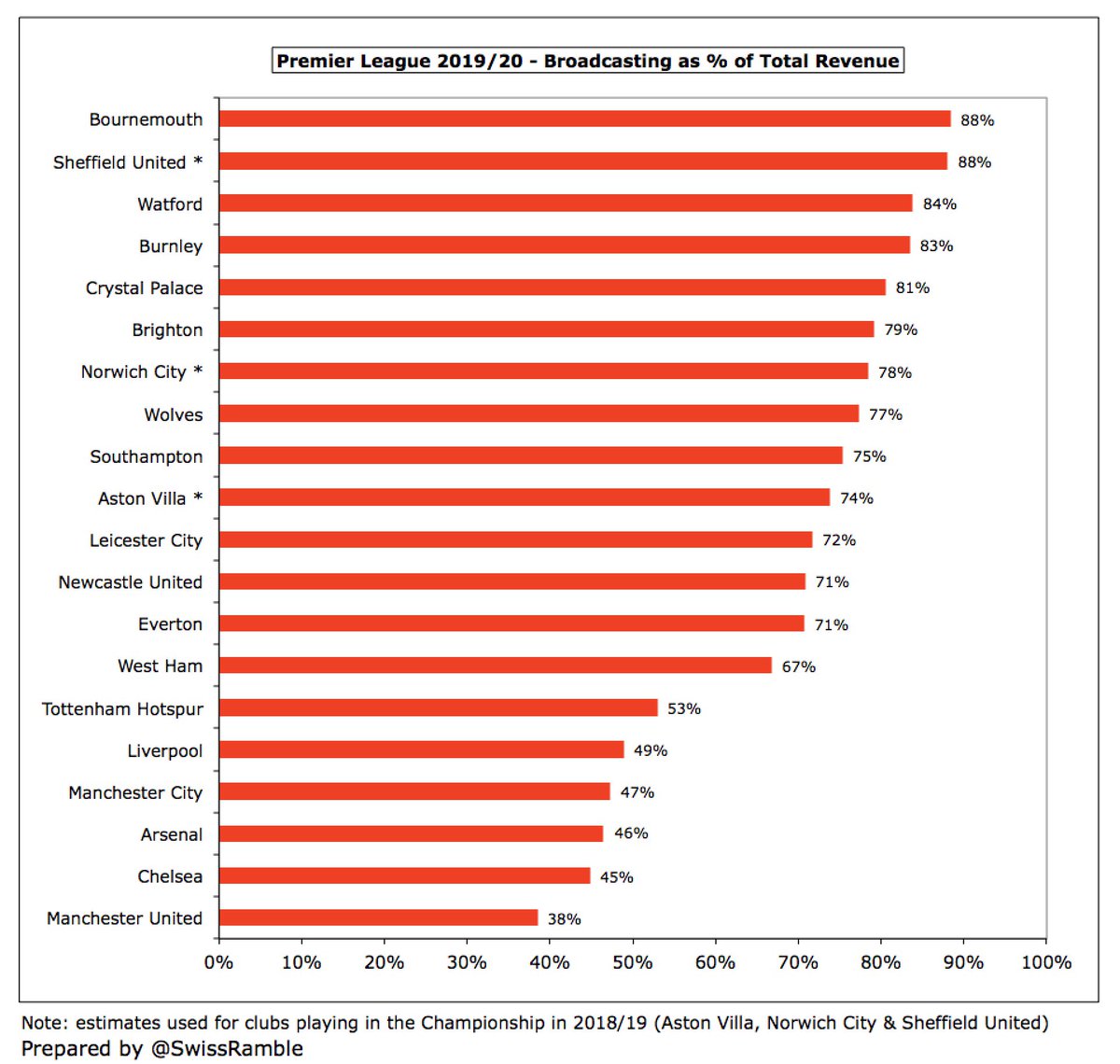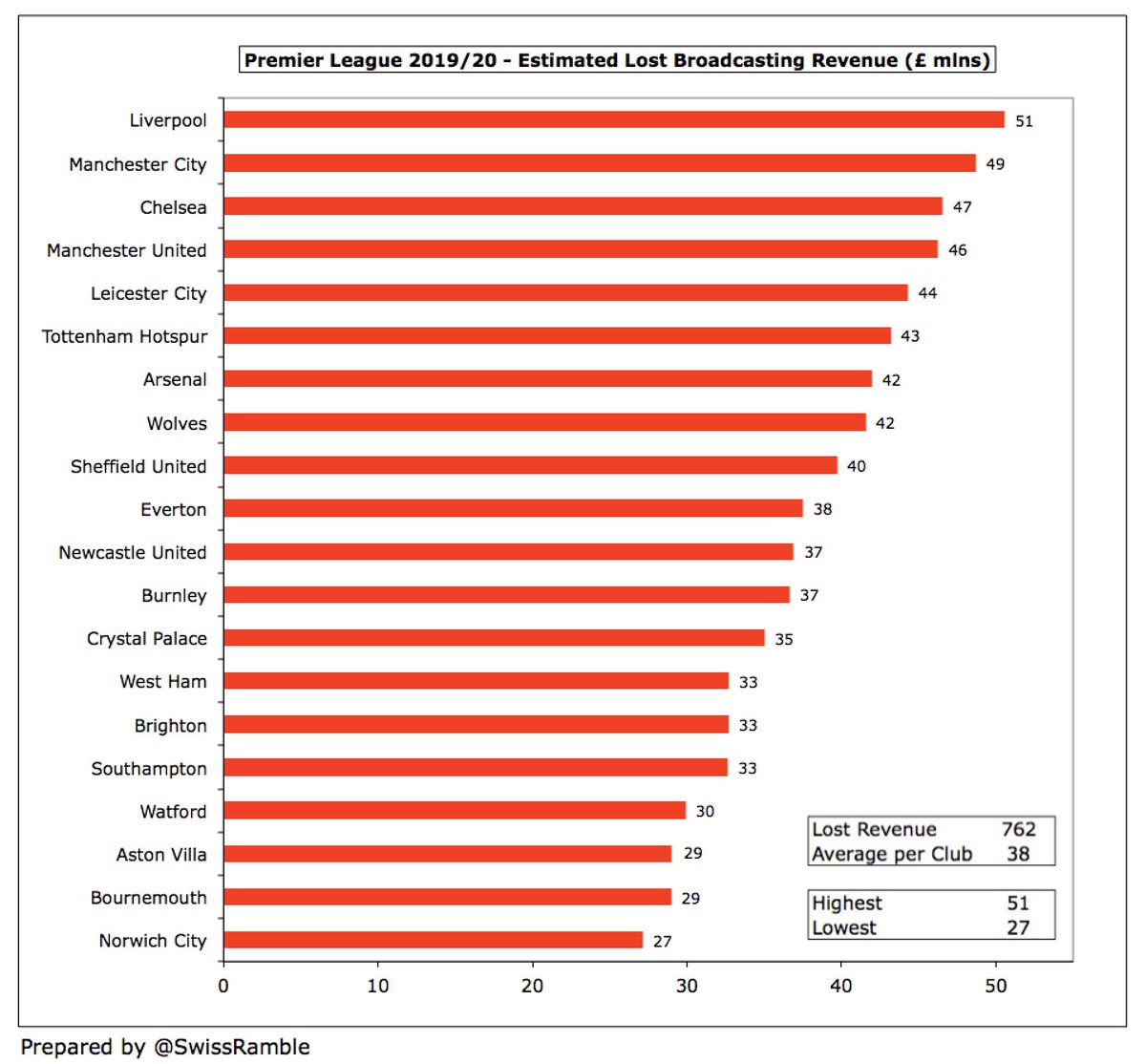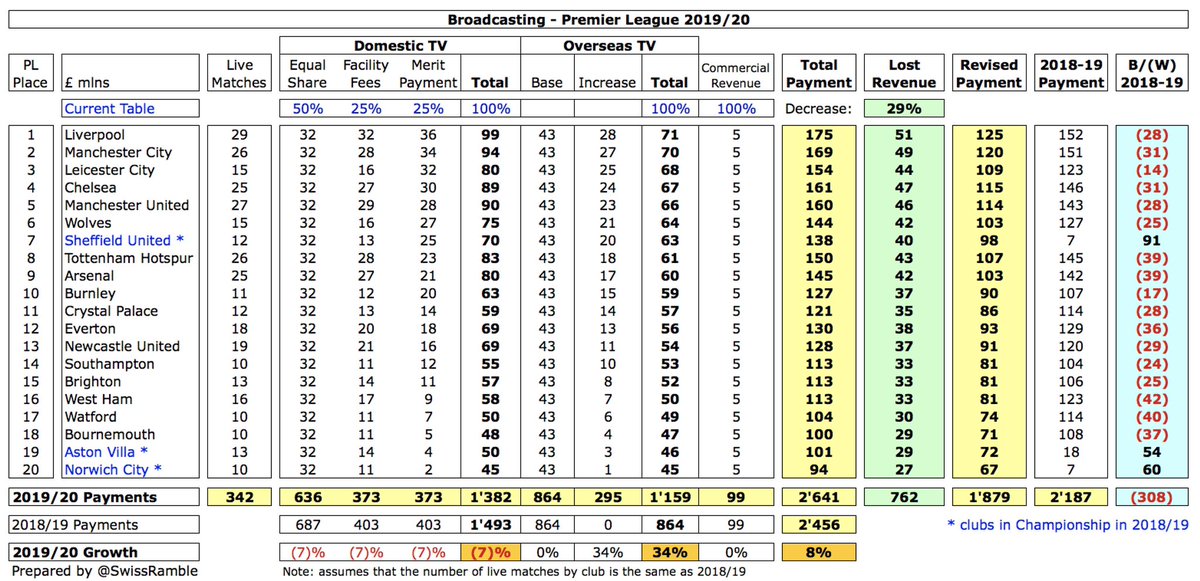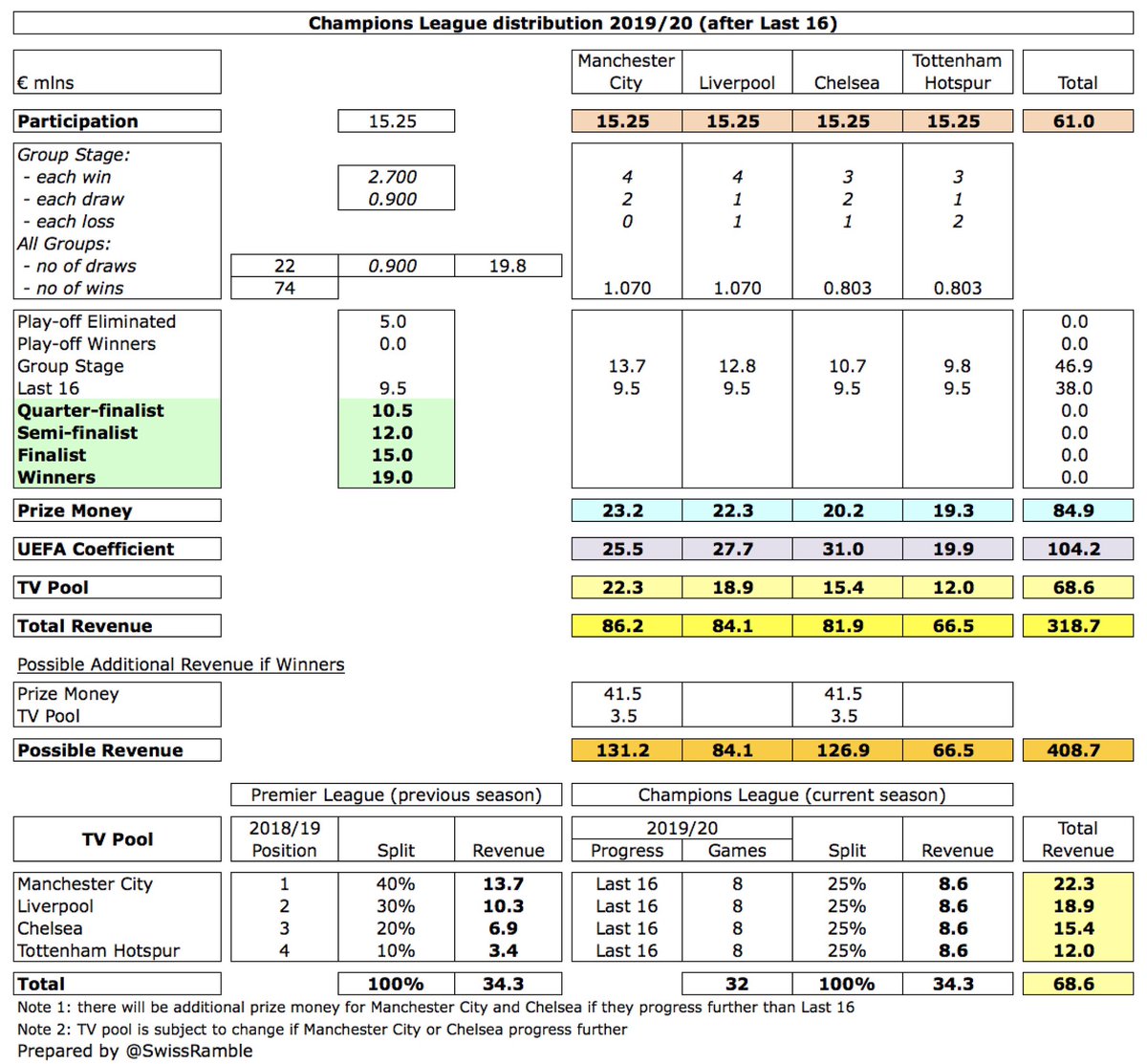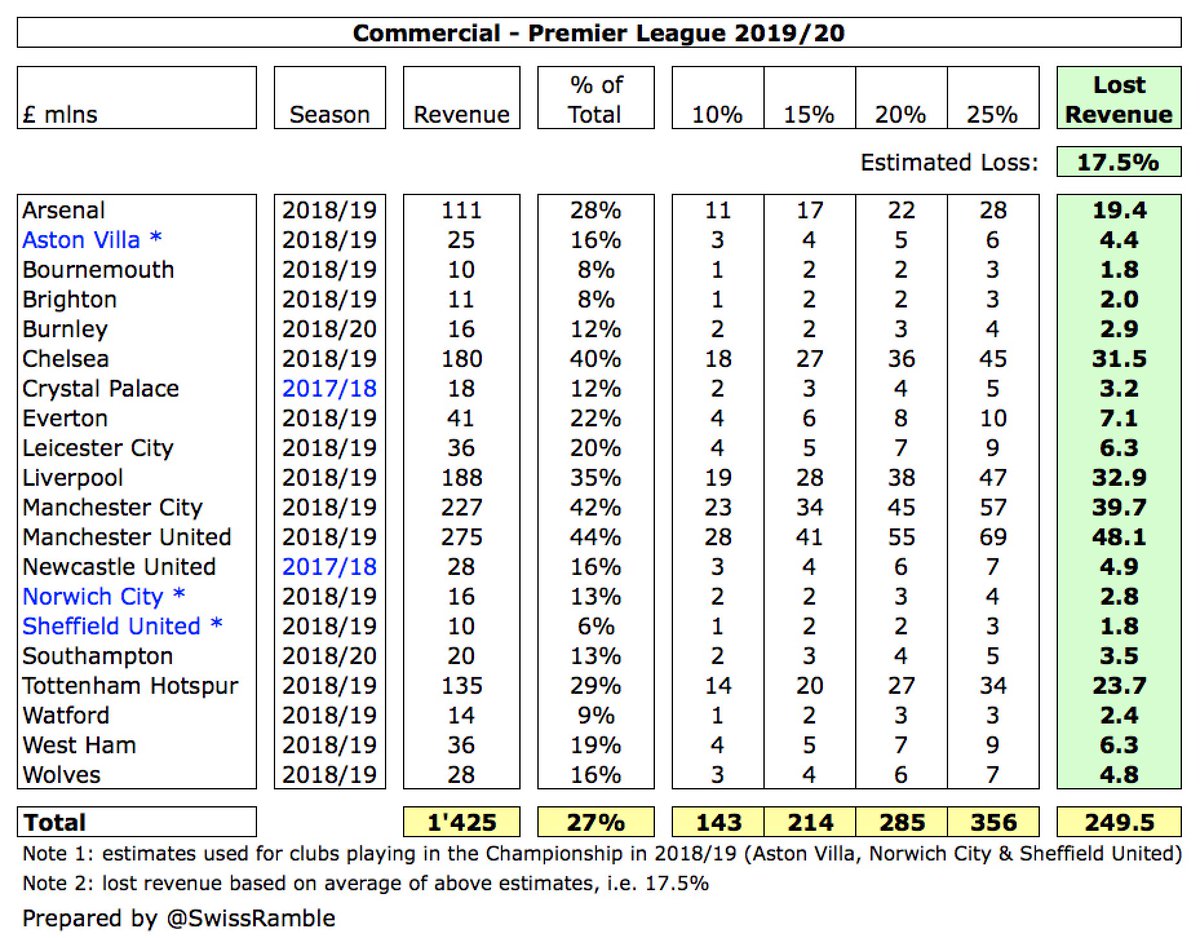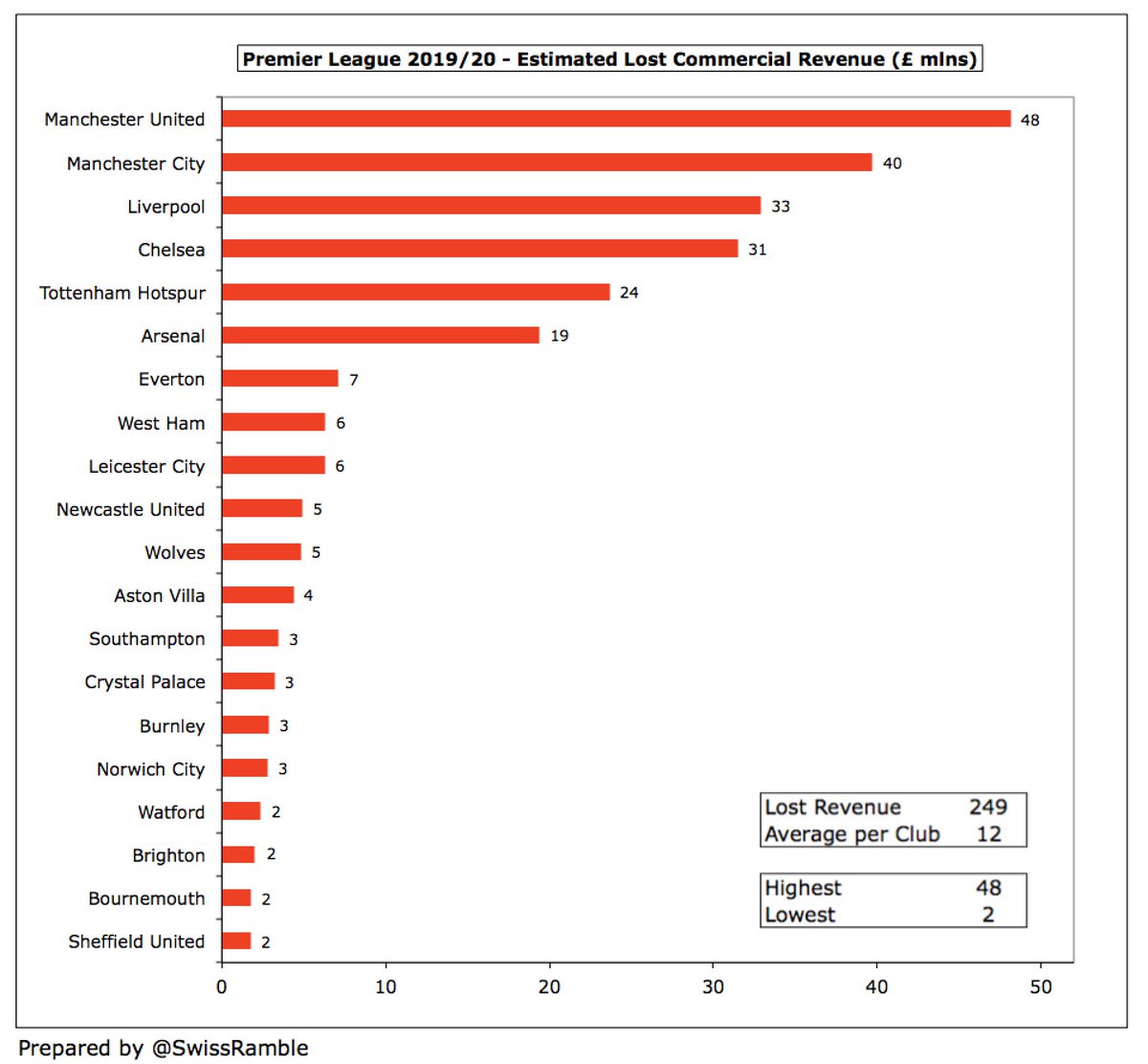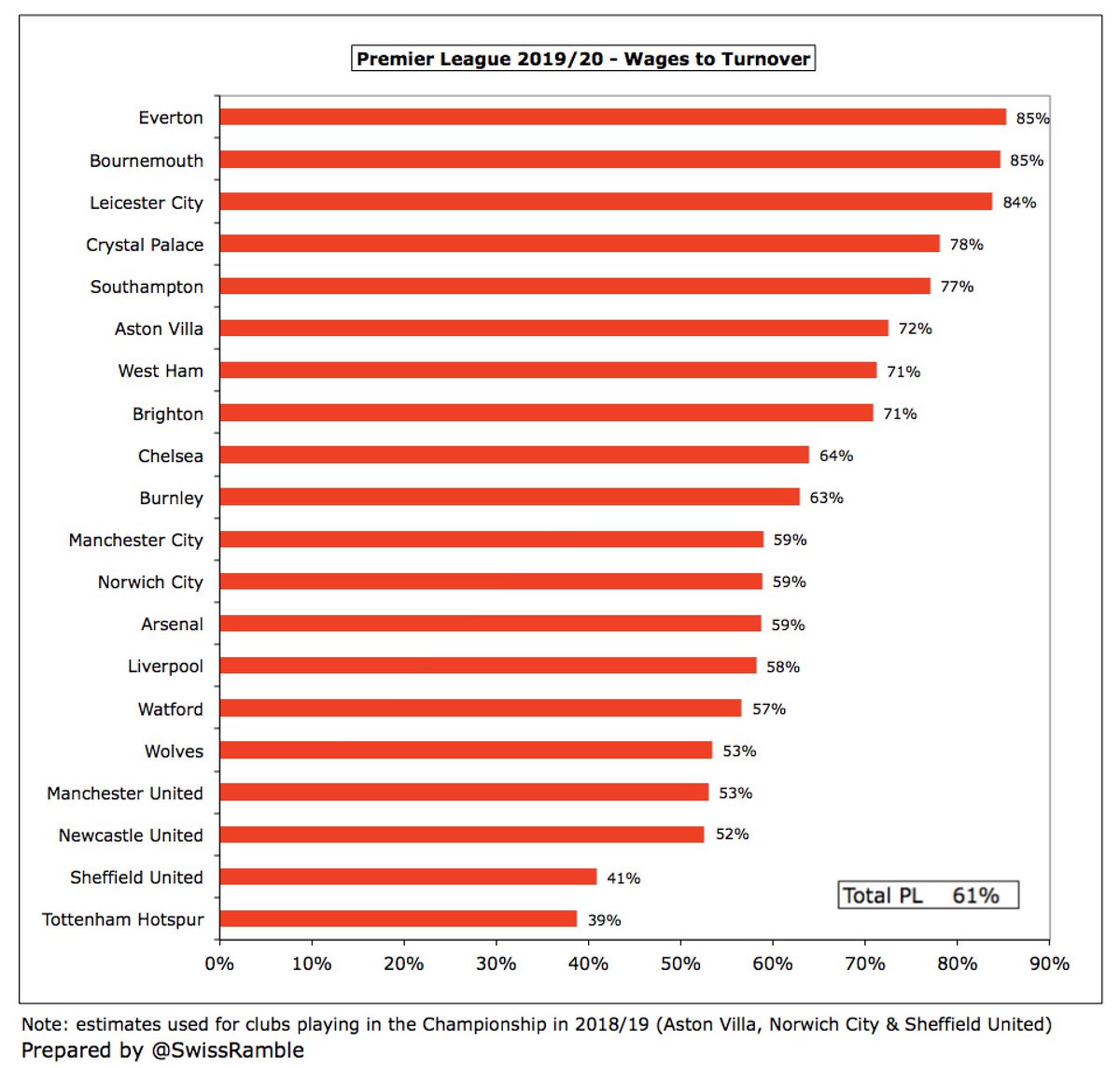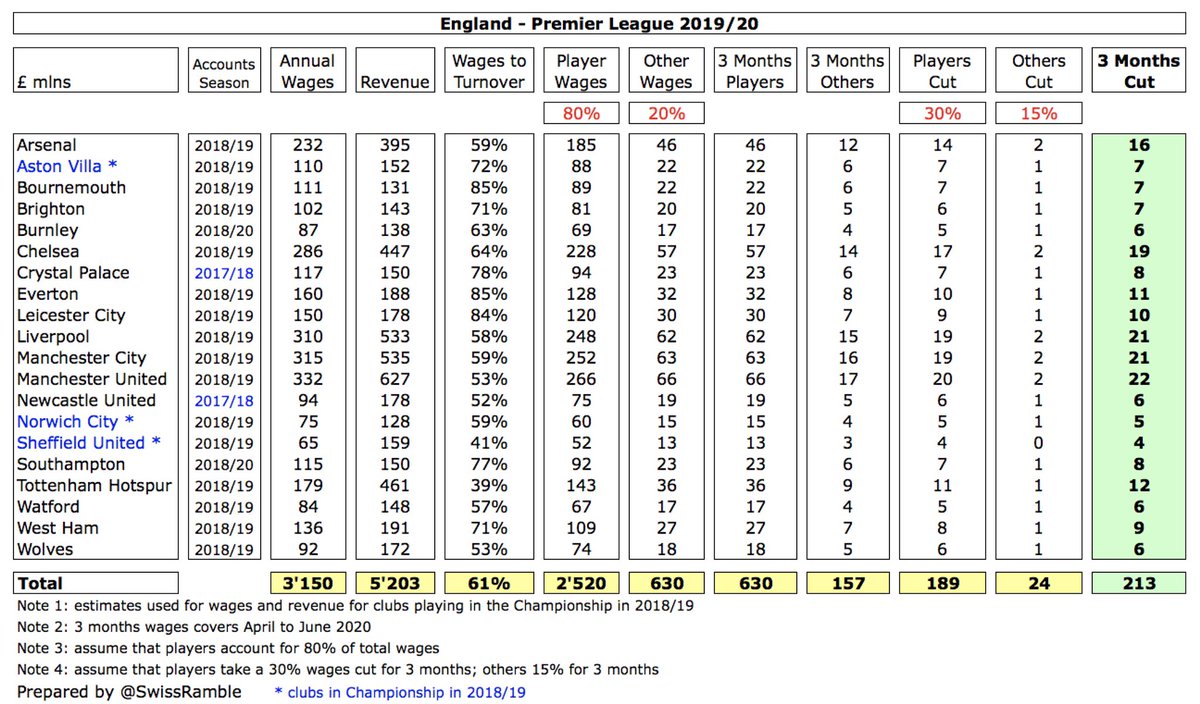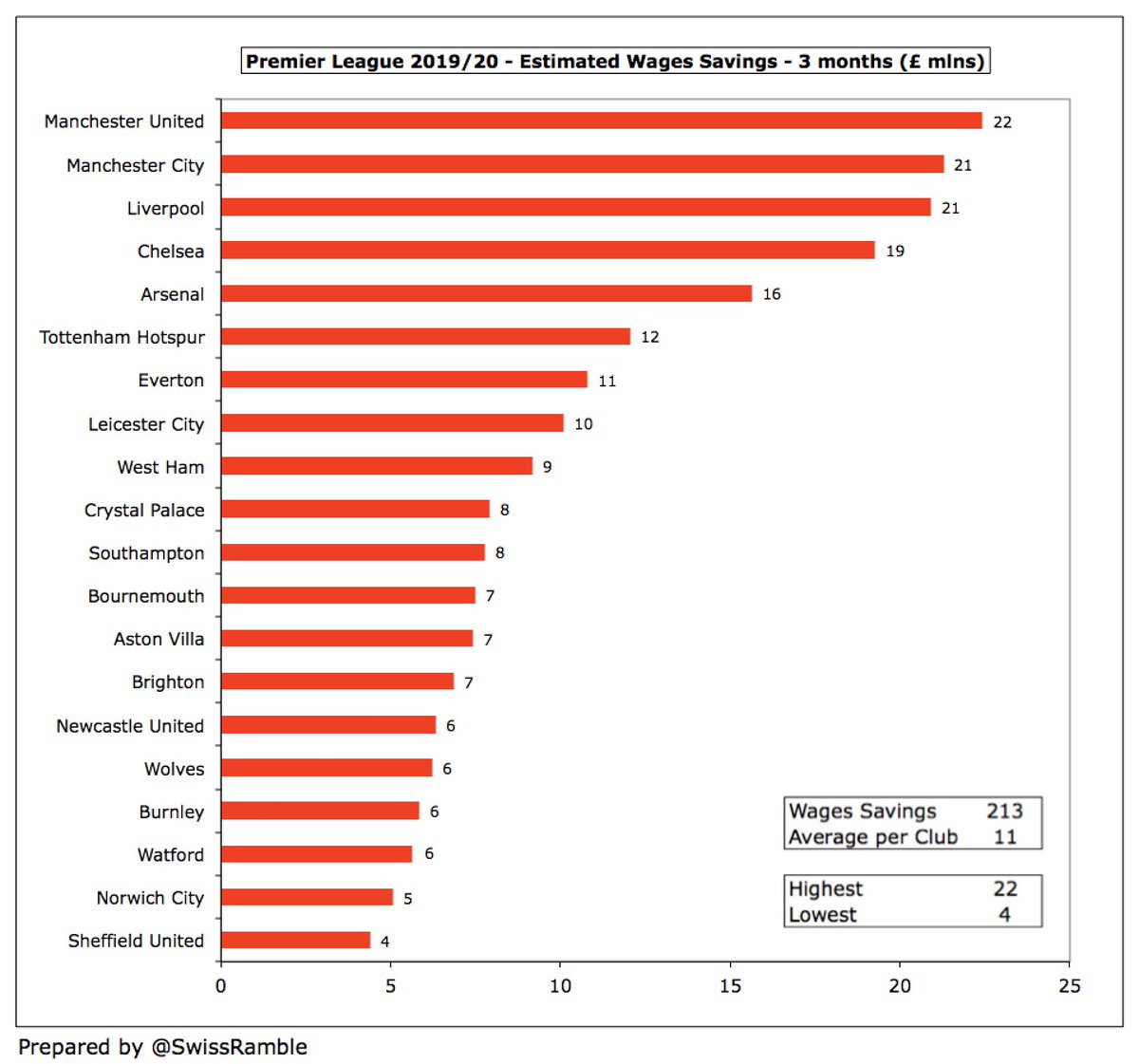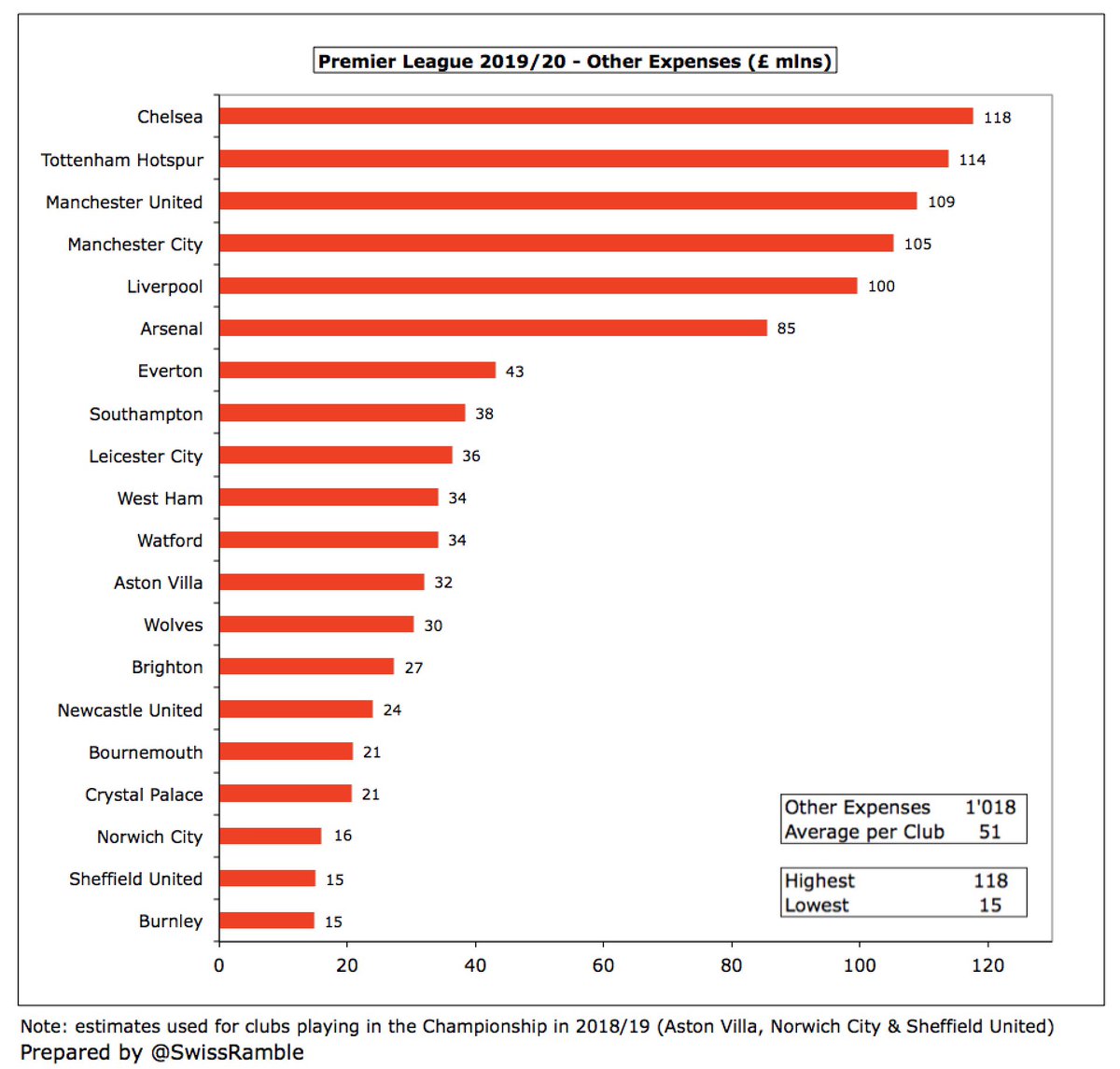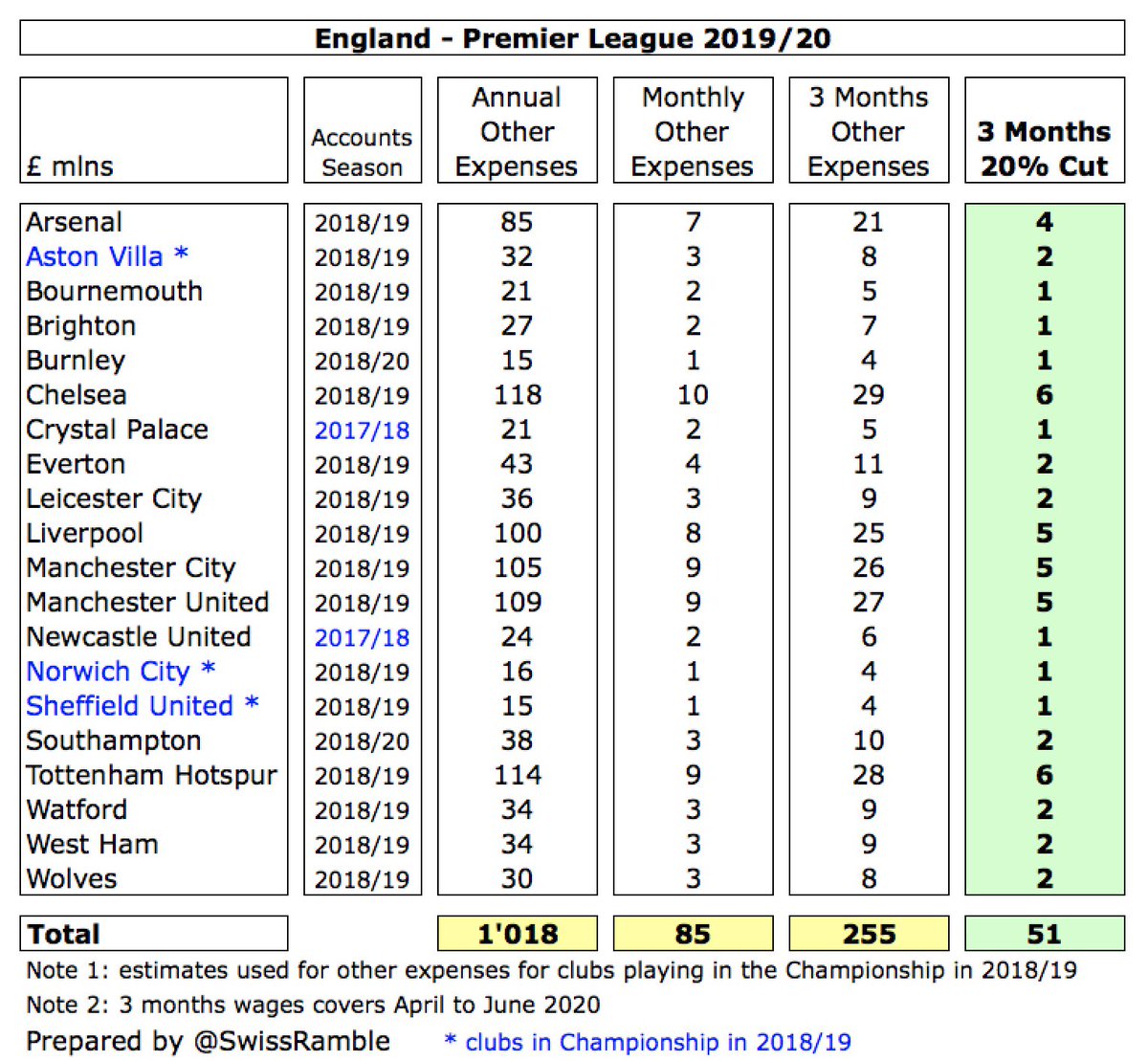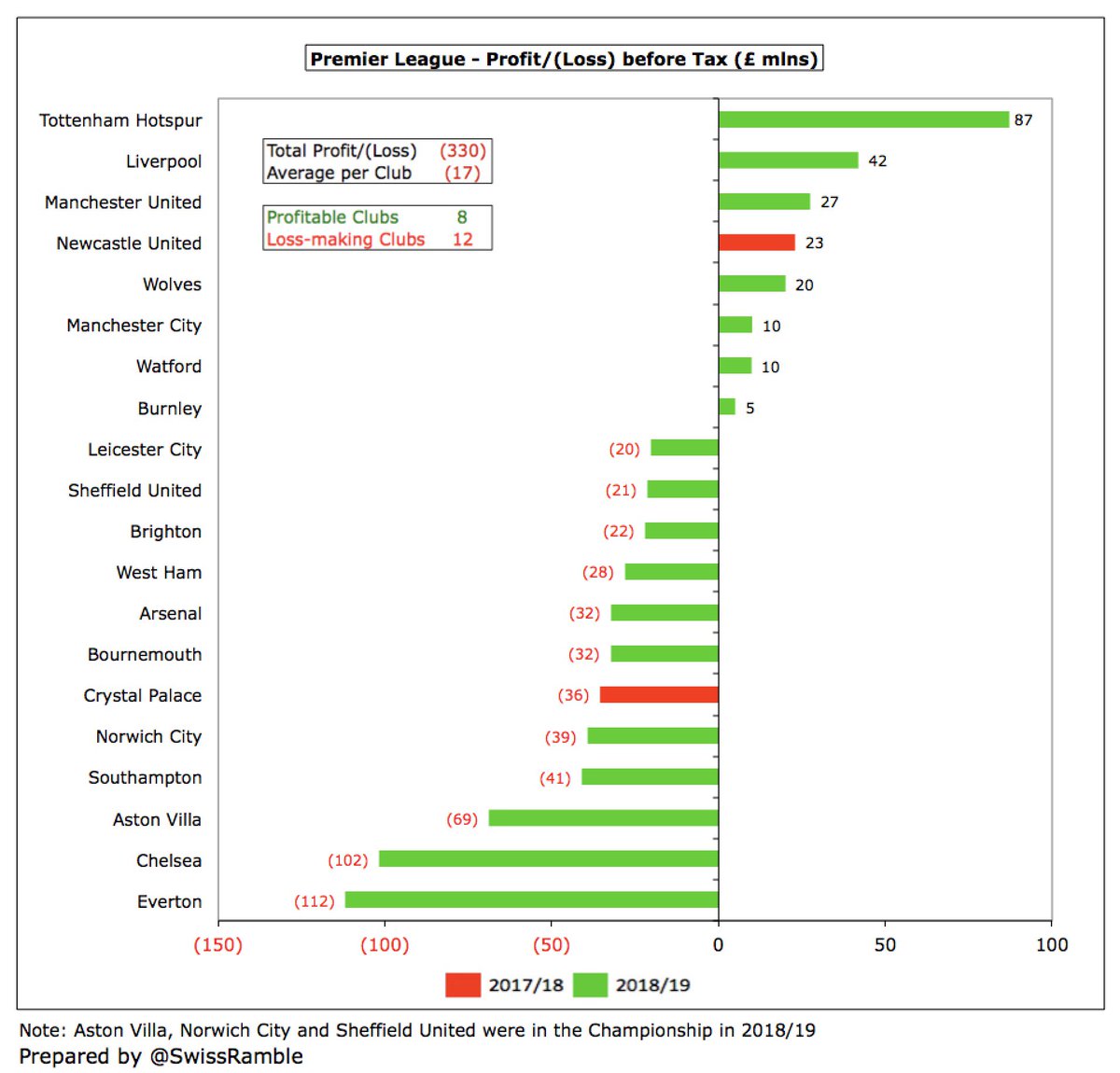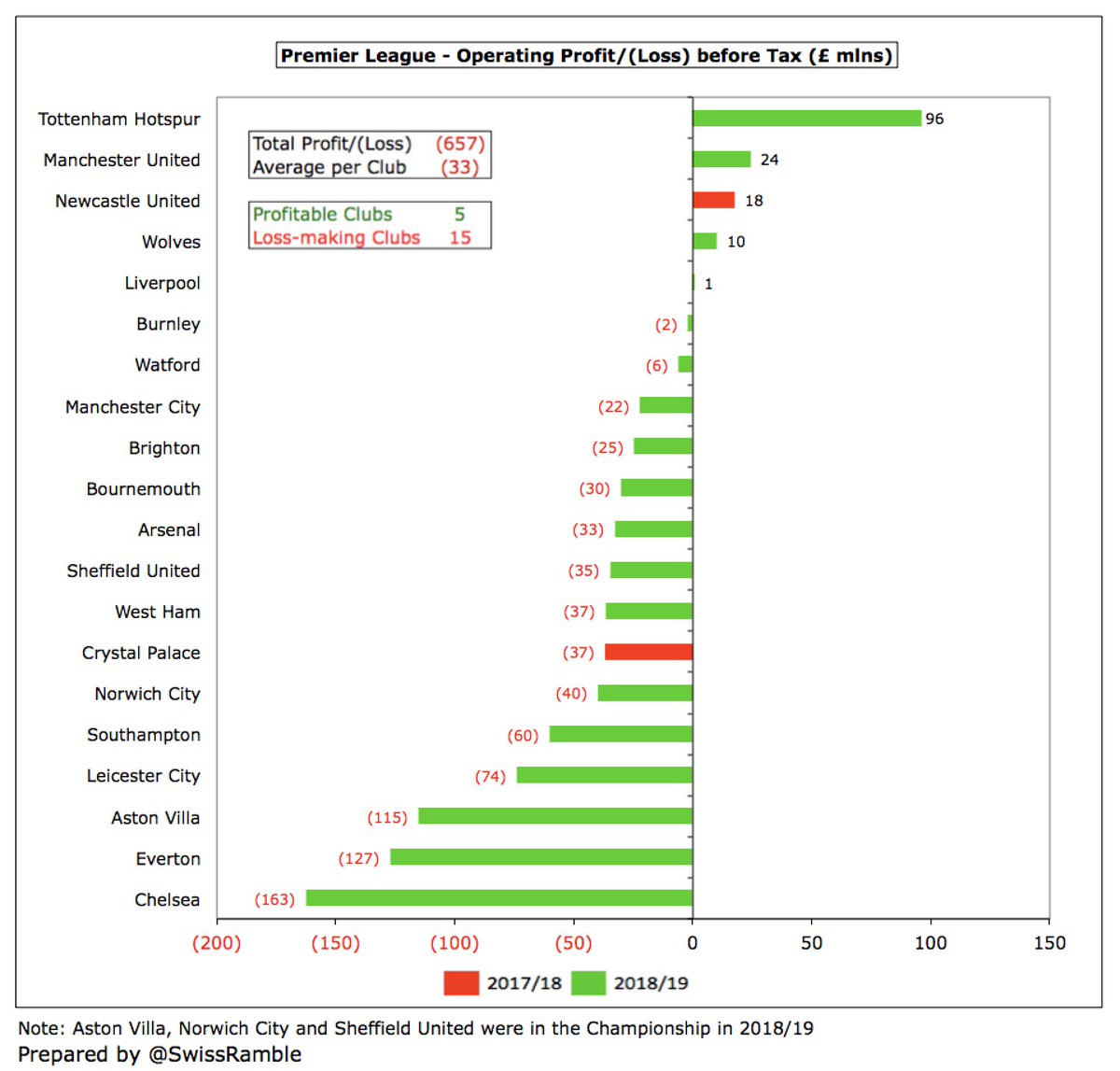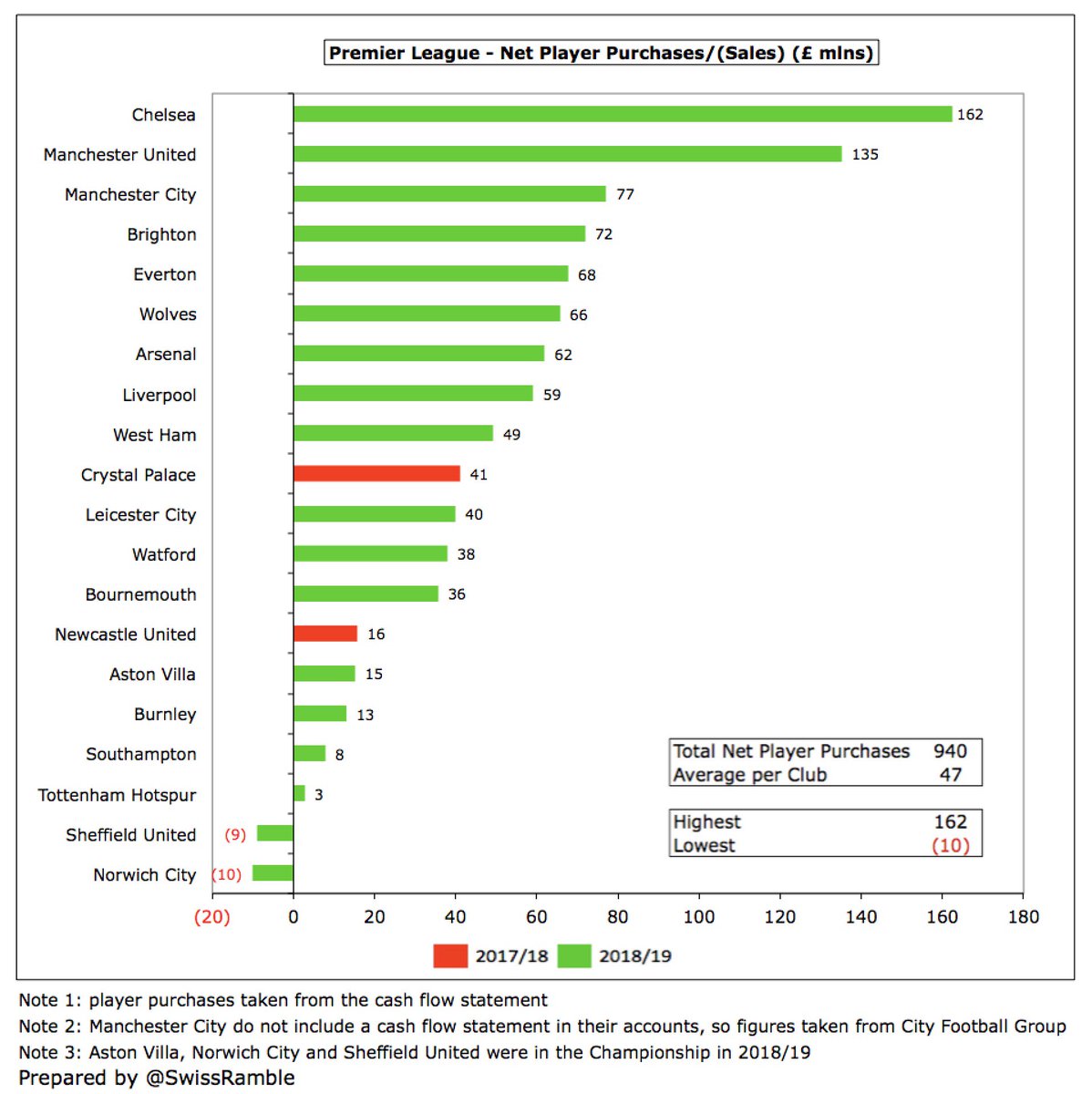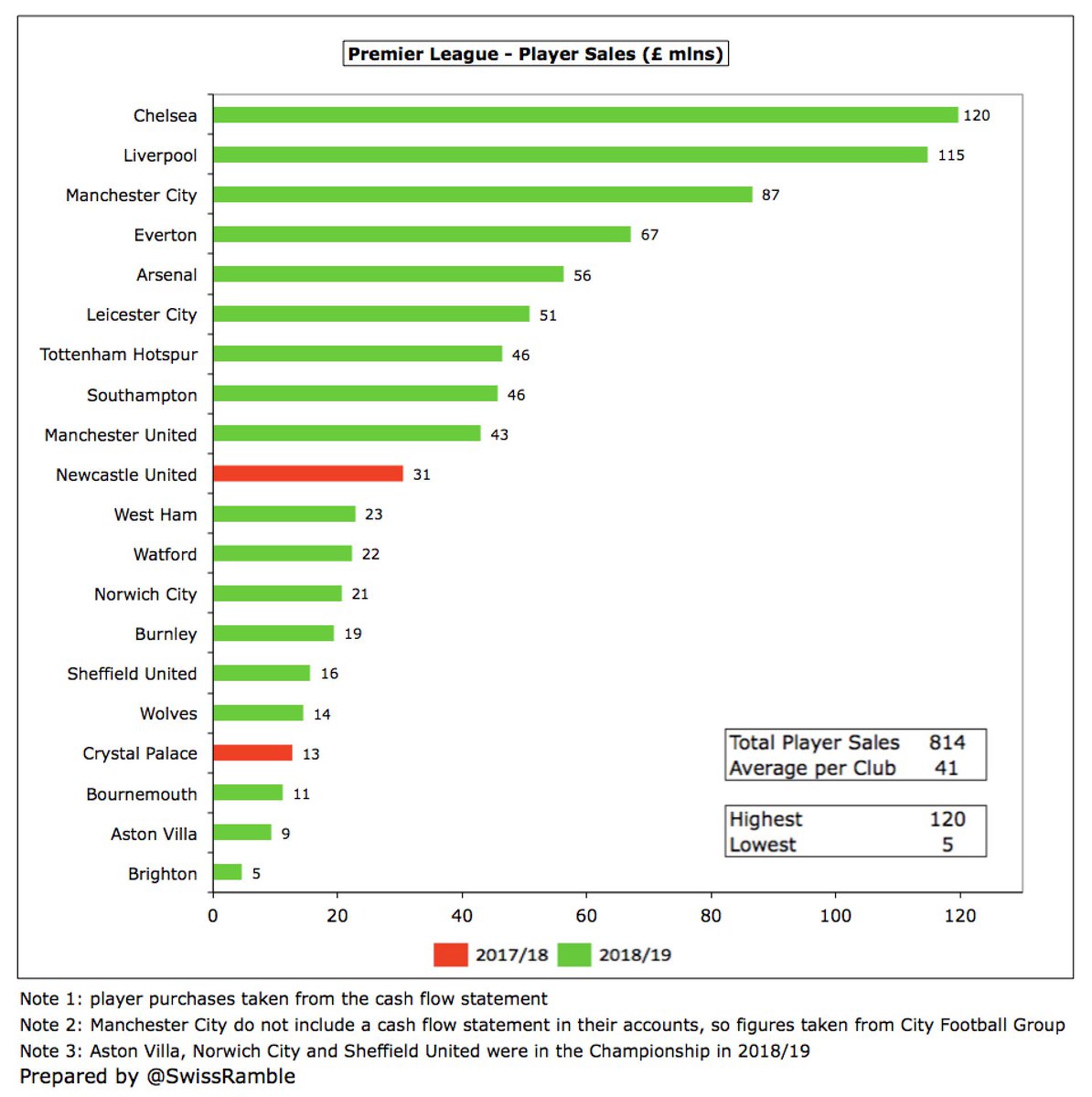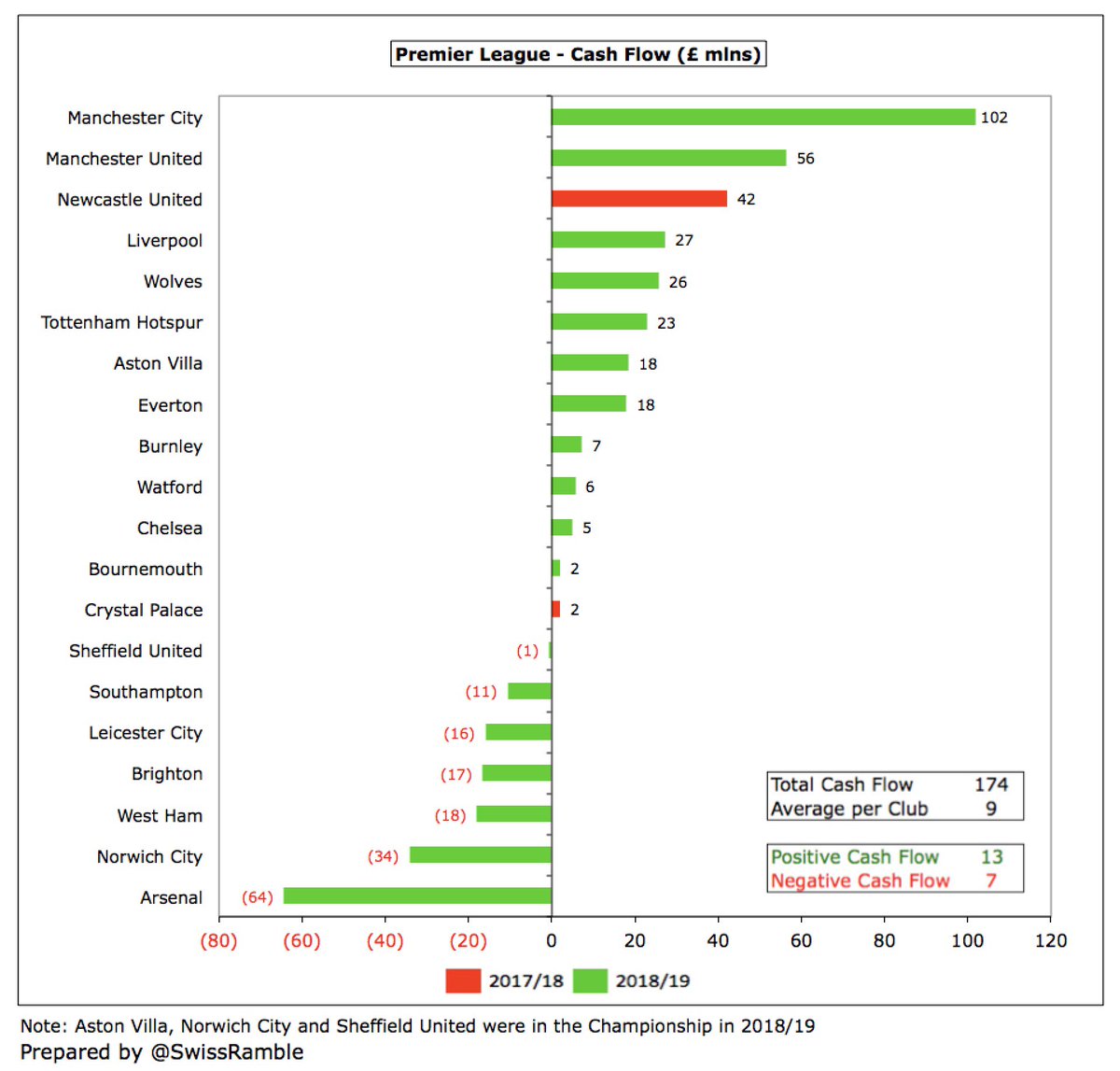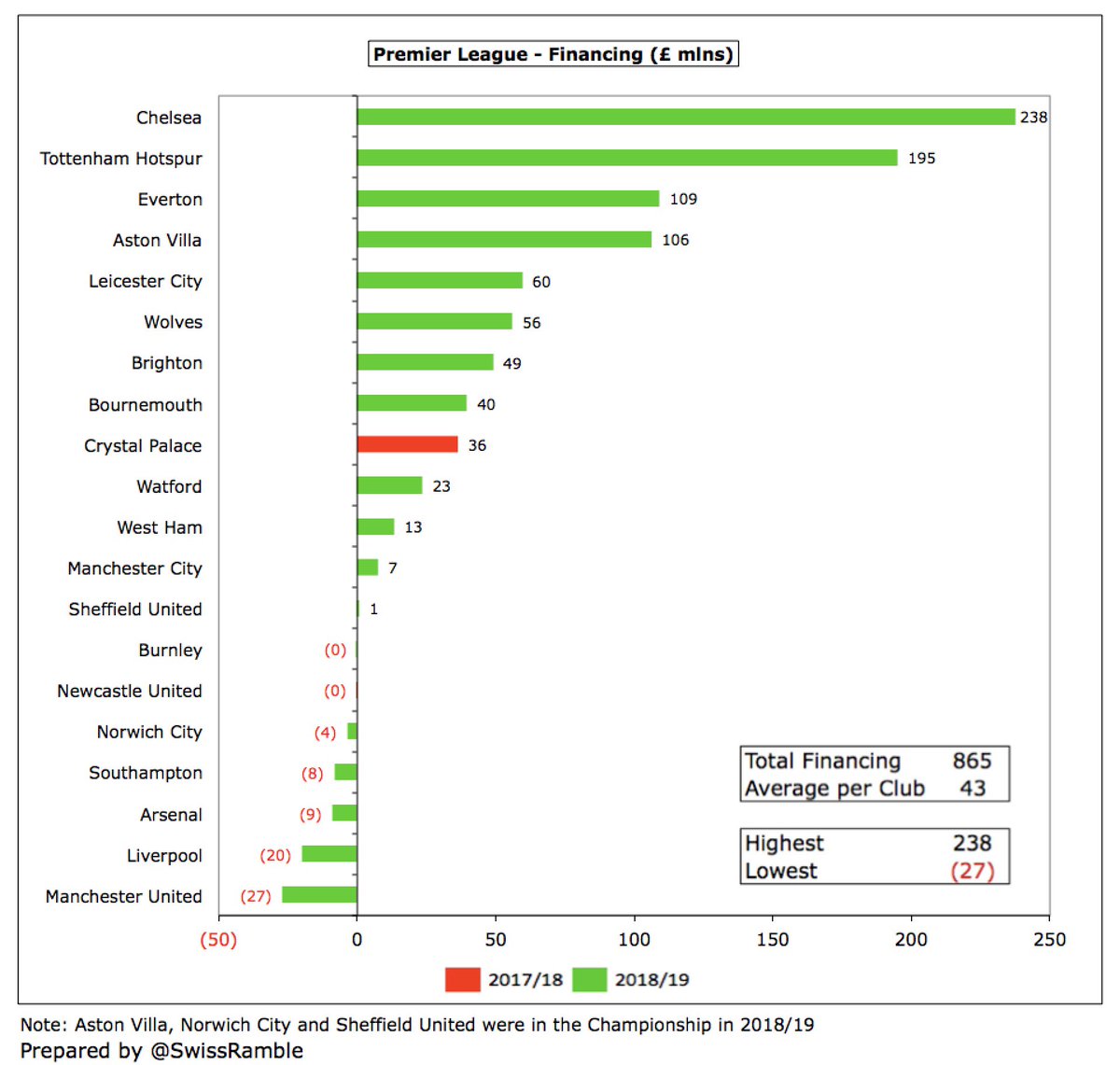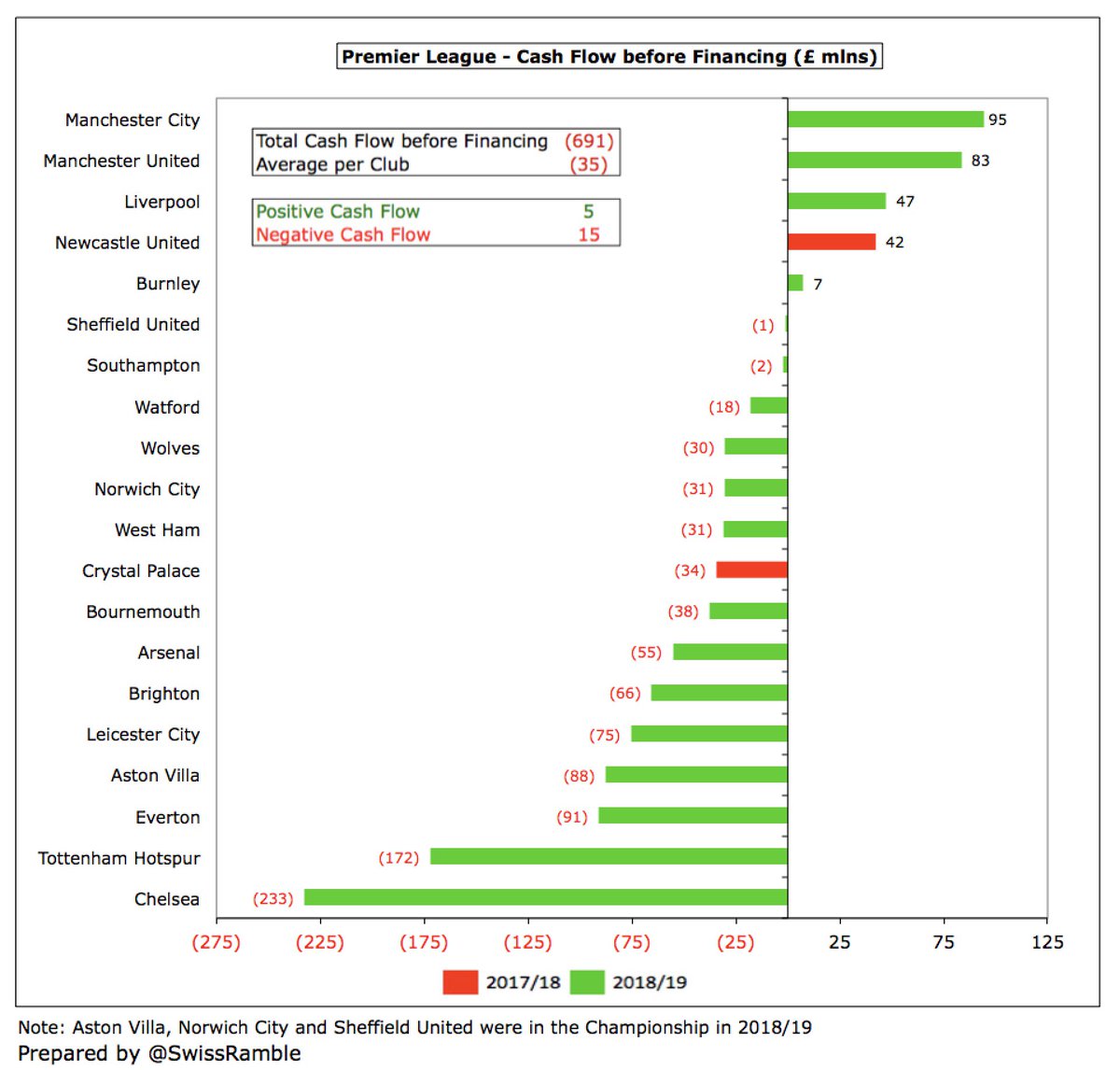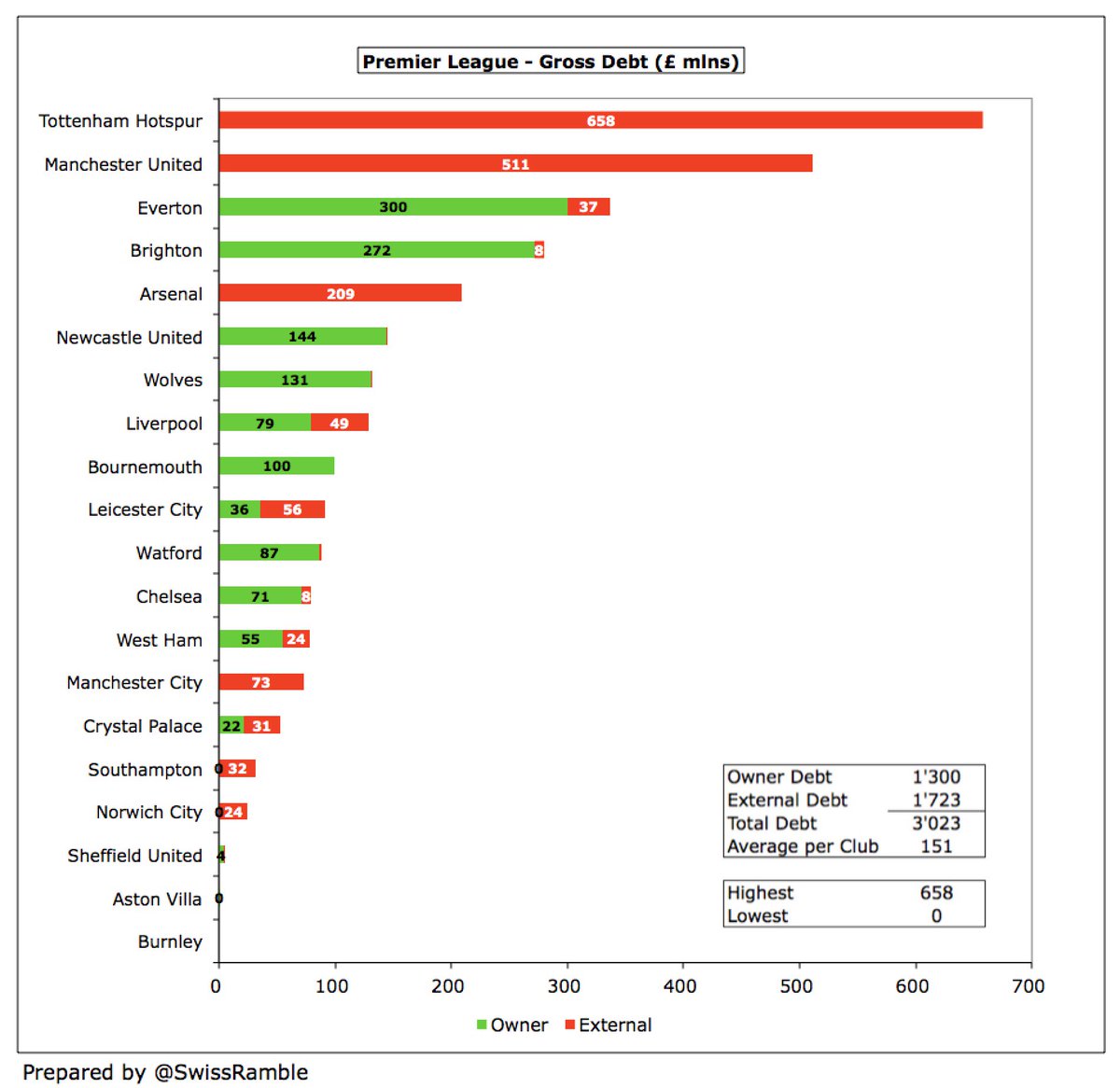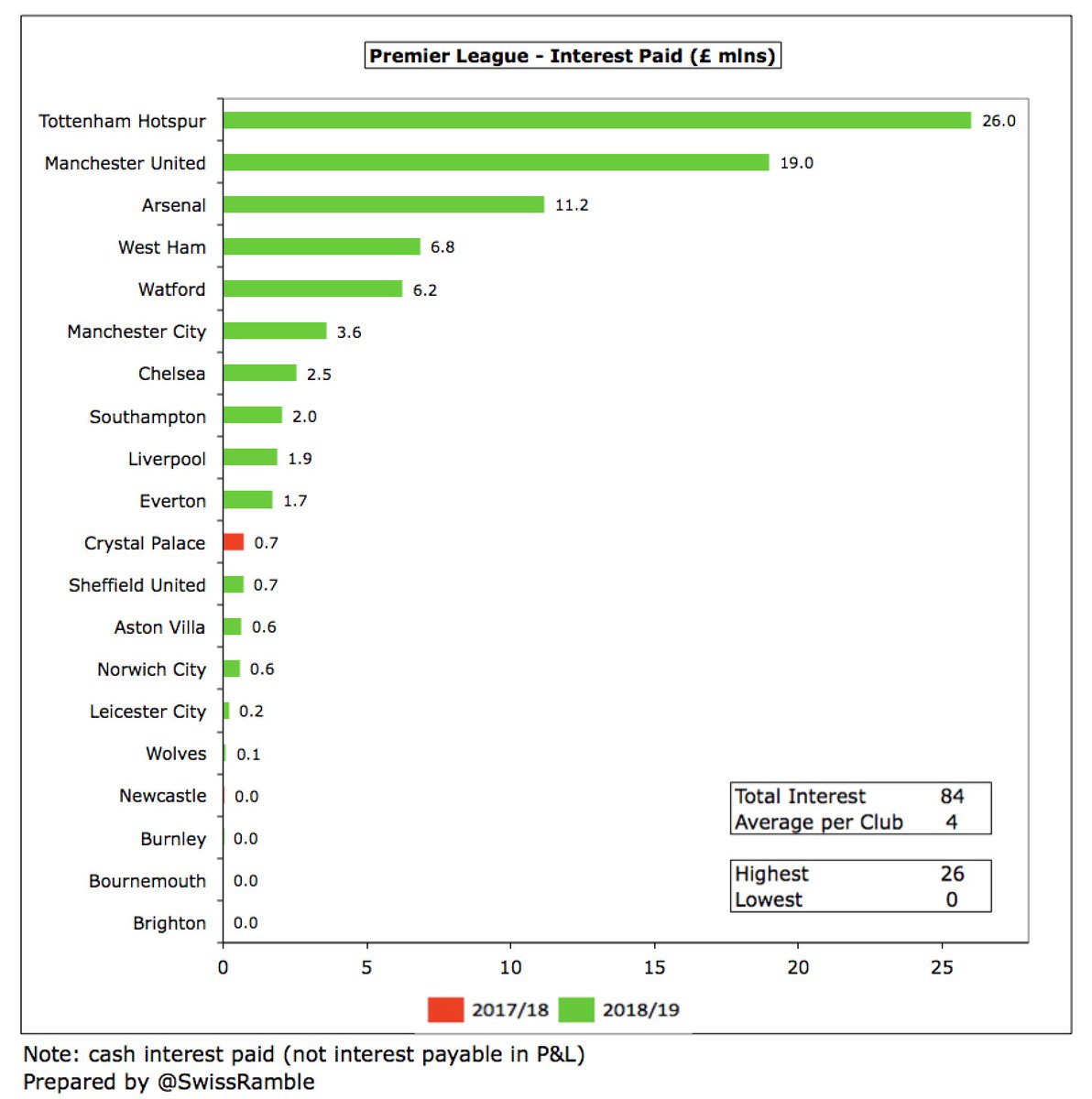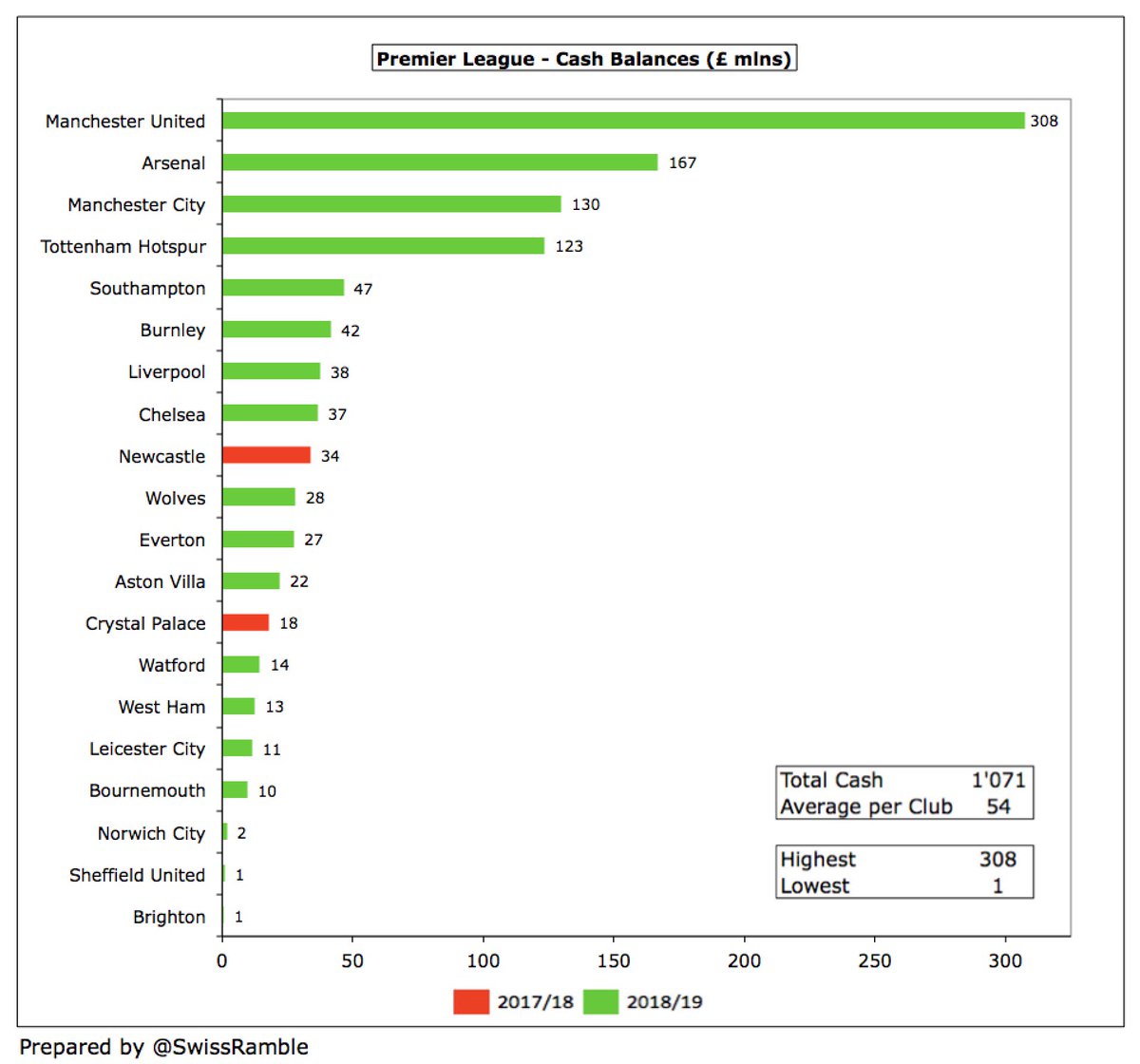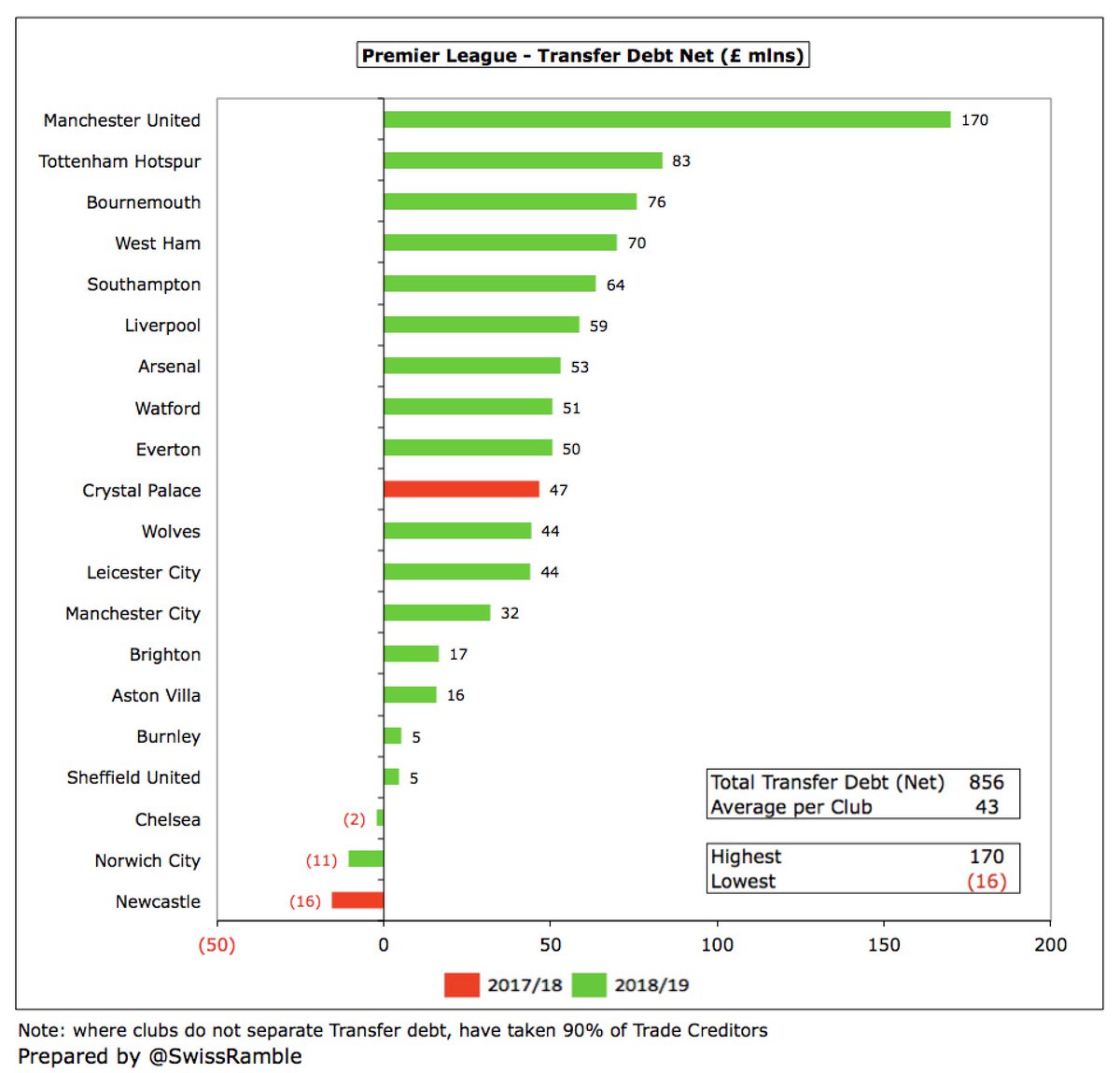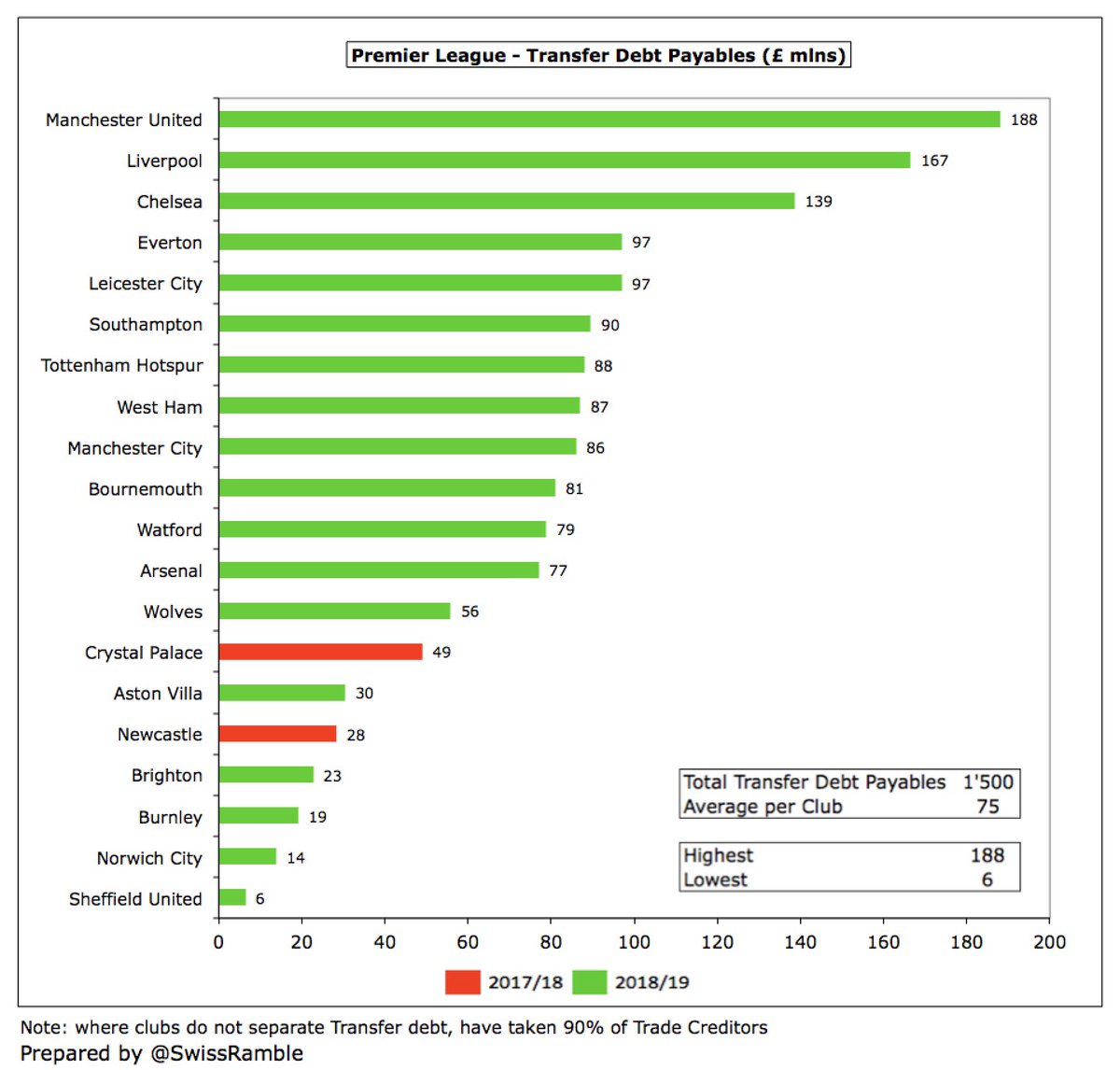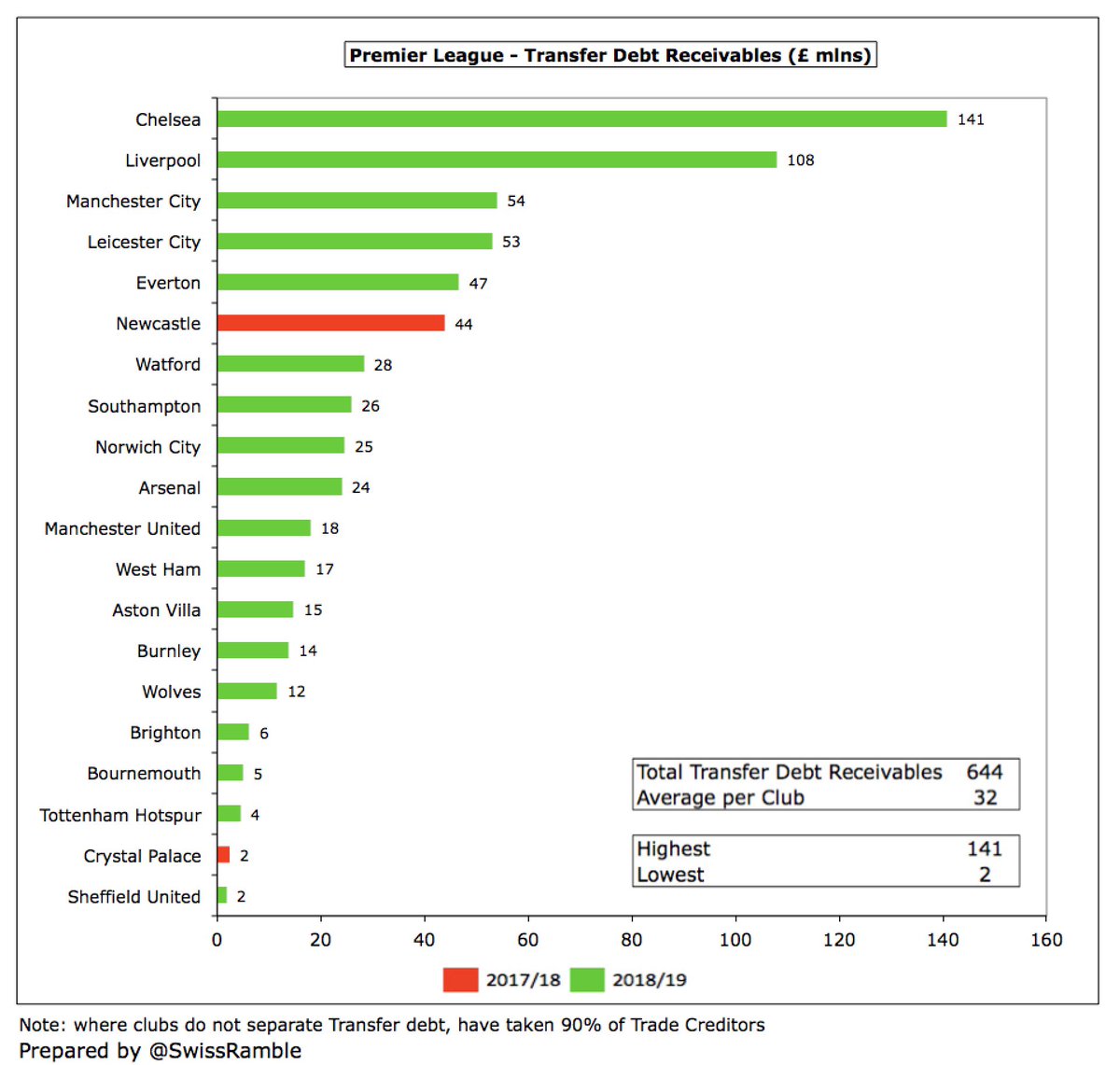This thread revisits the impact of the coronavirus pandemic on the football world, specifically focusing on the Premier League. Although England’s top flight may be in a stronger position than lower leagues, it still faces immense financial challenges, due to lost revenue.
First, the usual caveat that many of the numbers used are estimates, based on figures that are not current (largely 2018/19 accounts), but they should give a decent indication of the impact. As John Maynard Keynes asserted, “It is better to be roughly right than precisely wrong.”
On the face of it, Premier League clubs should be fine, given that they generate an impressive £5.2 bln revenue between them. However, this disguises the fact that the Big Six account for £3 bln of this total, i.e. around 60%, leaving £2.2 bln shared between the other 14 clubs.
The highest earning club #MUFC £627m has 5 times as much revenue as the bottom club #NCFC (estimated) £128m. Furthermore, the gap between the 6th placed club ( #AFC £395m) and 7th placed club ( #WHUFC £191m) is over £200m. In short, all Premier League clubs are not equal.
Premier League CEO Richard Masters told clubs they would lose £1.137 bln revenue if the season is not completed. My estimate is £1.131 bln, which is almost identical, though my split is a bit different: match day £120m, TV £762m, commercial £249m. Either way, it’s a lot of money.
Bearing in mind these are just estimates, PL clubs would lose between £32m and £111m. The two Manchester clubs would lose the most ( #MUFC £111m and #MCFC £100m), while the rest of the Big Six would also be significantly hit: #LFC £96m, #CFC £86m, #THFC £82m and #AFC £74m.
However, revenue loss is also still very much a major issue outside the Big Six, as proportionally the hit is worse. For example, #LCFC £53m and Burnley £41m would lose around 30% of their revenue, while #MUFC £111m is equivalent to “only” 18% of their revenue.
Match day in the Premier League only accounts for 13% of total revenue, but it is still worth £686m. It is also an important revenue stream at many clubs, e.g. four clubs generate more than £80m here: #MUFC £111m, #AFC £96m (24% of their total revenue), #LFC £84m and #THFC £82m.
Based on average revenue per match multiplied by the number of league games remaining (4 to 6, depending on the club), the loss in match day income would be £120m for the Premier League, ranging from #MUFC £17m to #AFCB £1m.
Broadcasting is far more important in the Premier League, accounting for £3.1 bln revenue, led by #LFC £261m (smallest is £100m estimate for #NCFC). This is worth 59% of total revenue, but is as much as 88% at #AFCB and more than 70% at no fewer than 13 of the 20 clubs.
The major concern for Premier League clubs is a potential £762m loss of TV money (Sky £371m, BT Sport £50m, overseas £341m), which is around 29% of normal payment. Assuming this 29% reduction is applied equally to each club, the loss would range from #LFC £51m to #NCFC £27m.
It is worth noting that 2019/20 TV deal is 8% higher than previous season (domestic down 7%, overseas up 34%), so the loss compared to 2018/19 would be partially offset, especially as overseas increase is based on league position, e.g. #LFC loss would be £28m (instead of £51m).
As a technical aside, my estimate assumes that the entire £762m loss would be borne by the 20 Premier League clubs, but it is possible that this would also impact parachute payments to Championship clubs. In this case, the losses to PL clubs would be lower.
The size of the potential TV loss explains why there is so much talk about completing the season by playing games behind closed doors, maybe in a quarantined camp. Also reports that TV companies will not demand repayment, given that they will be bidding for new rights in future.
Instead, options under discussion with TV companies include extending the current rights, awarding additional live games next season (for the same money) or allowing them to broadcast all remaining games this season (on top of contracted games) if played behind closed doors.
Cash flow is an important factor in TV payments, so Premier League has agreed to pay clubs their final tranche early (based on current league position). On the other hand, TV companies may well delay the first payment for next season (normally June/July) until situation clearer.
It is unclear what will happen in Champions League, so I have excluded it from my calculation. #LFC & #THFC already eliminated in last 16, so no issue for them. #CFC also likely to go out, but #MCFC well placed to progress (worth: QF €10.5m, SF €12m, final €15m, winner €4m).
Commercial revenue losses are difficult to estimate, as contracts are confidential, but likely that sponsors will push for reductions, as marketing budgets among first to be cut in an economic crisis. Based on 17.5% of income (average of 15% and 20%), the loss would be £249m.
Using this simple % of revenue approach, #MUFC would lose the most with £48m, as they have the highest commercial income of £275m. The Big Six would lose between £19m and £48m, but all other clubs would “only” lose between £2m and £7m, which does not feel overly damaging.
However, there will be a problem at end of season when many shirt sponsorships & kit deals come to an end, so will be up for negotiation in a much tougher market. Even when already signed, may be issues, eg. new #LFC Nike deal has lower fixed fee with more linked to retail sales.
Premier League’s annual wage bill is £3.2 bln, though there is a large disparity with #MUFC, #MCFC and #LFC all above £300m, while 6 clubs pay less than £100m. Average wages to turnover is a respectable 61%, but 8 clubs are above 70%, including 3 around 85% ( #EFC, #AFCB & #LCFC).
Assuming that player wages are 80% of total wage bill (£2.5 bln), a 30% cut for 3 months would mean £189m savings. Adding a 15% cut for other staff (£630m) would only give £24m savings, making furloughs at some clubs even less defensible. Total savings amount to £213m.
Highest wage savings would obviously be at clubs with highest wage bills, so 3 months would produce around £20m at each of the top four clubs over 3 months, followed by #AFC £16m and #THFC £12m. For the same period, savings would be £8m or less at the bottom 11 clubs.
Of course, clubs are still in discussions with players over possible reductions, so the analysis is theoretical at this stage. One interesting question is whether clubs should be allowed to spend in the transfer market if they have cut staff wages before making up any shortfall.
Although wages are the biggest element of a football club’s cost base, other expenses (excluding player amortisation, depreciation, interest and tax) are also fairly significant at around £1 bln in the PL. These are over £100m a year at all the Big Six except #AFC £85m.
Such costs are sometimes fixed, e.g. rent and supplier contracts, so not always easy to reduce in the short-term. However, if we assume that clubs could cut 20%, this would add up to £51m over 3 months. This would be worth £5-6m at #CFC, #THFC, #MUFC, #MCFC and #LFC.
The reality is that football did not look like a particularly healthy business even before coronavirus arrived, as the current Premier League clubs posted a combined £330m loss with 12 of them losing money, including two reporting deficits over £100m, namely #EFC and #CFC.
Even these figures were boosted by £388m once-off profits on player sales, led by #CFC £60m and #LCFC £58m. Any club whose business model relies on player trading must be concerned, as it seems likely that the transfer market will collapse this summer, leading to lower prices.
Excluding profits on player sales, Premier League clubs have reported £657m operating losses with only 5 being profitable. The largest operating losses are #CFC £163m and #EFC £127m, while Daniel Levy’s conservative approach has resulted in #THFC operating profit of £96m.
However, some might argue that operating losses are overstated, as they include player amortisation (i.e. the cost of player trading), but exclude profits from player sales. If we then look at EBITDA to address this, the situation looks much better with 14 clubs being profitable.
Even EBITDA (Earnings Before Interest, Depreciation & Amortisation) does not give the full picture, as we need to somehow include player trading. As Warren Buffett said, “References to EBITDA make us shudder – does management think the tooth fairy pays for capital expenditures?”
Therefore, we should also look at player trading from a cash perspective, i.e. instead of the accounting entries for amortisation and player sales. On this basis, Premier League clubs spent a net £940m last year on players with the largest outlays at #CFC £162m and #MUFC £135m.
Premier League gross cash spend in the transfer market was a hefty £1.8 bln in just one year, though again massive differences between clubs. #CFC splashed out £282m, while at the other end of the spectrum we find Burnley £32m (promoted clubs spent less in the Championship).
The spend was partially offset by £814m of cash from player sales with #CFC 120m again leading the way, followed by #LFC £115m and #MCFC £87m. Even in the Premier League, some clubs do not make big money from this activity, e.g. #BHAFC £5m and #AFCB £11m.
Overall, cash flow looks pretty good in the Premier League with net inflow of £174m and 13 clubs with positive cash flow. The largest increases in cash were produced by the Manchester clubs, #MCFC £102m and #MUFC £56m. In contrast, #AFC cash balance dropped £64m.
However, this does not tell the full story, as these positive cash inflows were very largely driven by £865m of financing, either from club owners or banks. Four clubs required injections of more than £100m: #CFC £238m, #THFC £195m, #EFC £109m and #AVFC £106m.
So a more realistic assessment of Premier League strength is cash flow before financing, where total net outflow is £691m with only 5 clubs having positive cash flow. In contrast, 7 clubs had cash outflow above £50m, the highest being #CFC £233m (players) & #THFC £172m (stadium).
Debt/interest payments may be an issue when cash flow is tight, though it’s difficult to say, as this will partly depend on whether debt is owner or external (though owners may have problems with their own businesses to solve). Repayment terms vary and may be rescheduled.
Premier League clubs have around £3 bln of financial debt, split £1.3 bln owner debt and £1.7 bln external debt. Largest amounts owed: #THFC £658m, #MUFC £511m, #EFC £337m, #BHAFC £280m and #AFC £209m. In contrast, Burnley, #AVFC and #SUFC have virtually no debt.
Premier League clubs paid £84m interest last year, though two-thirds of this was at just three clubs: #THFC £26m (stadium), #MUFC £19m (leveraged purchase) and #AFC £11m (stadium). United also paid £23m dividends to their owners.
At such times, cash is king. Premier League has £1.1 bln, but worth noting that £728m of this is at just 4 clubs: #MUFC £308m (down to £101m at half-year), #AFC £167m, #MCFC £130m & #THFC £123m. Other clubs have much less, e.g. #BHAFC £1m. #WHUFC raising £30m with rights issue.
Premier League clubs also have £1.5 bln transfer debt for stage payments (£856m net of receivables). Potentially an issue for smaller clubs, e.g. #AFCB owe £76m net. La Liga president Javier Tebas has warned of a domino effect in global football if liabilities are not paid.
Although the Premier League is better off than lower leagues, it clearly is not without its own financial problems. The impact of the pandemic might even be to further widen the gap between the “haves and the have nots”, as richer clubs look to take advantage of others’ weakness.

 Read on Twitter
Read on Twitter